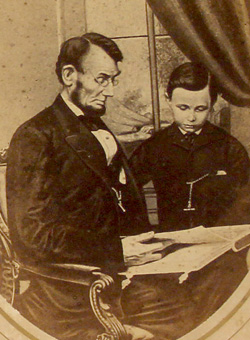
Please send all Checks and Money orders to :
Dave Taylor P.O. Box 87 Sylvania, OH 43560
419-842-1863
Click Here to E-mail Us!
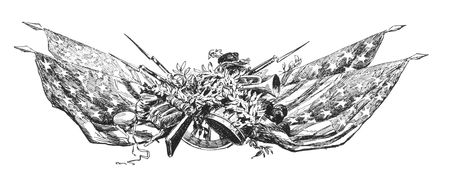
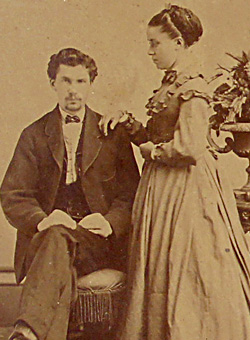
15 03
LAYAWAYS ARE WELCOME:
Need to split your order into multiple payments? No problem! A simple 20% earnest money deposit will hold your item for you.
You can then pay it off in easy installments that fit your budget.
Read Terms Here
~~~~~~~~~~
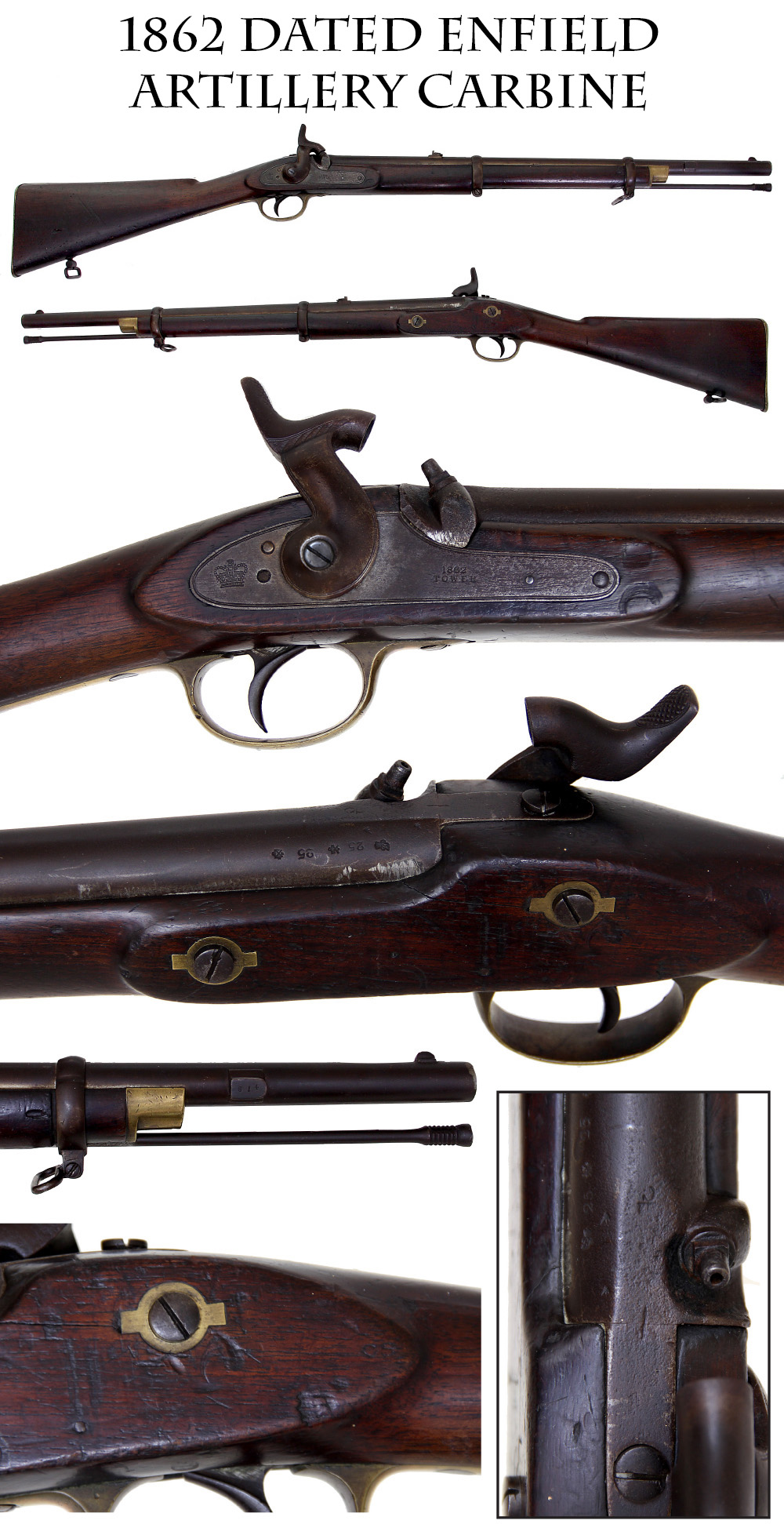
15-03-01 … Jeb Stuart’s Favorite Gun — Extremely Scarce Enfield Artillery Carbine:
Pattern 1858 Artillery Carbine in Very Good++ condition overall. 100% complete, mechanically perfect, and 100% original. The gun retains the original and correct multi-leaf rear site, both original sling swivels, etc… . The saber bayonet lug is numbered 814 and the bayonet would have born the same number. Retains an original knurled ramrod that I believe is a cut down musket rod as there are no threads present on the bottom end. The gun is clearly marked at the breech with the Birmingham proofs, including the 25 gauge marks showing the gun is .577 caliber, and consequently there were 25 bullets to the pound. The lock plate has the standard Crown to the rear of the hammer and is marked 1862 / TOWER forward of the hammer. The name of the contractor who produced the gun is stamped in the toe of the stock: J. Cook & Son. This is John Thomas Cook and son of Birmingham. From 1855 -1861 his company was at 88 Shadwell Street and 80 New Street, and in 1862 he moved the New Street location to Bridge Street West. These guns were imported by both North and South, more by the South. Very few records survive but one extant shows that 1,620 artillery carbines were imported through the port of Wilmington, NC between July 19, 1863 and December 3 of 1864. The Artillery Carbine was greatly respected by Confederate General J.E.B. Stuart.
An October 7, 1862 requisition from him reads in part: “Application from General Stuart, commanding cavalry, to exchange rifles, for the Enfield carbines (artillery) in the hands of our infantry …
a pretty solid endorsement I would say. In addition I find on a CW discussion page the following report … Ordnance Stores turned over at Canton MS, Sept 11th 1863, from Capt. Clark, O.O. Cavalry in MS, to Capt. Bond, O.O. Jackson’s Division:
33000 Enfield Cartridges cal .57
16000 Austrian Rifle Cartridges cal .54
96 Austrian Rifles cal .54
96 Bayonets
420 Artillery Carbines cal .57
420 Saber Bayonets
200 Cartridge Boxes 200 Cap Pouches
200 Waist Belts
200 Shoulder Straps.
A very scarce gun with solid southern affiliations in VG++ condition … ai
… $2,850.00 – SOLD
Click Here to E-mail Us!
Call us @ 419-842-1863
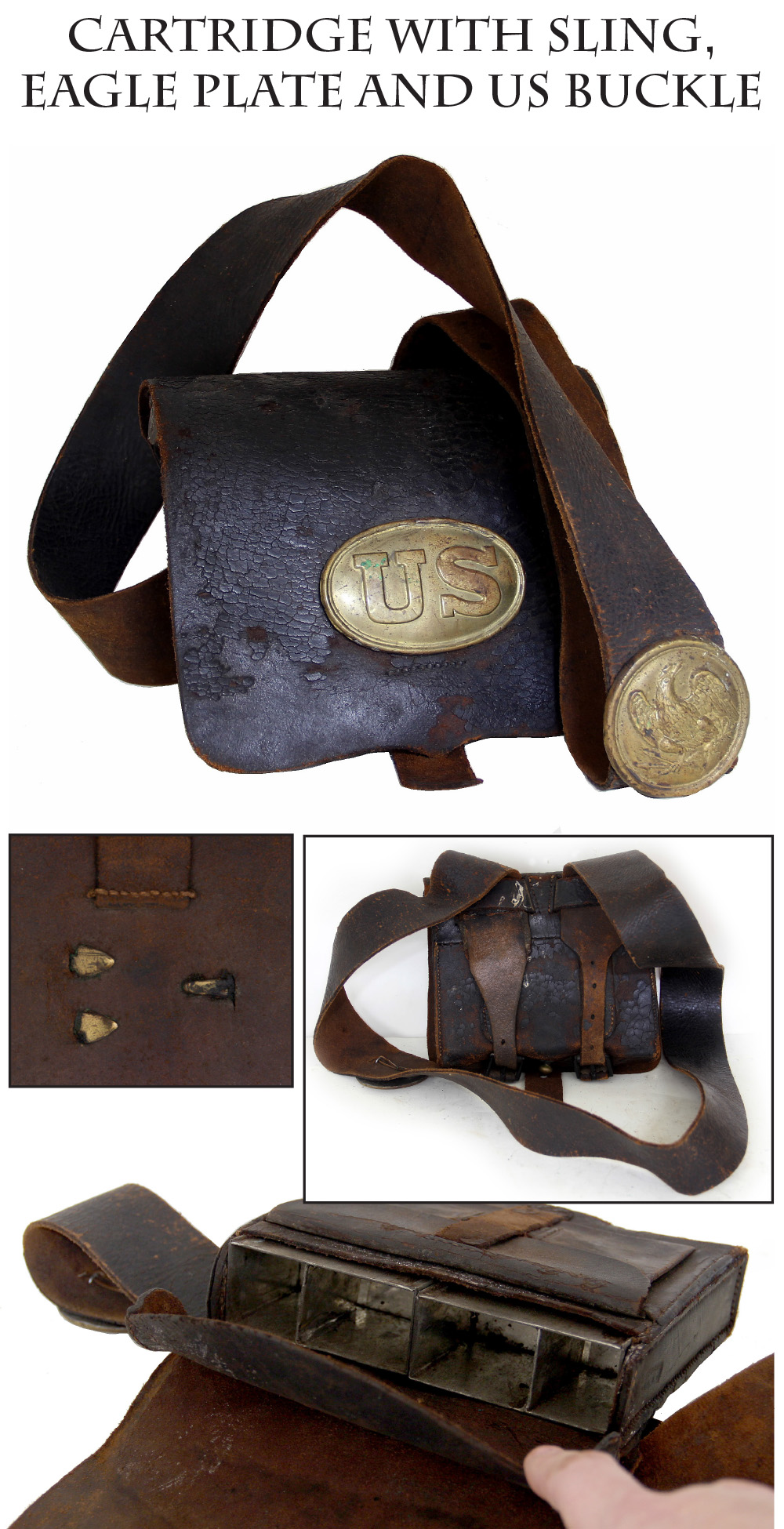
15-03-02 … Full Infantry Cartridge Box Rig Utilizing A Belt Plate For the Box Plate …
An untouched early war .58 caliber cartridge box rig complete with tins, shoulder belt and eagle crossbelt plate, utilizing an oval US belt plate in place of the cartridge box plate. I love real field modifications or soldier “make-do” pieces. In this case the infantryman lacked a box plate, but had an extra belt plate at hand and used that. One of his buddies may have found himself short a belt buckle when they finished polishing their brass for inspection, but it did the job. The box is the early war pattern with a straight line of stitching securing the latch tab without a rivet reinforcement. The tab is in place, as is the tool pouch, flap and tab, and both cartridge box tins, as well as the belt loops and buckles. The original bridle leather sling is still buckled in place and the round eagle shoulder belt plate is there too. Very good finish overall, minor crazing, some small finish loss to the cover from flexing, as is to be expected. A key piece of Civil War gear- dynamite to display with a rifle musket
… $1,150.00 – SOLD
Click Here to E-mail Us!
Call us @ 419-842-1863
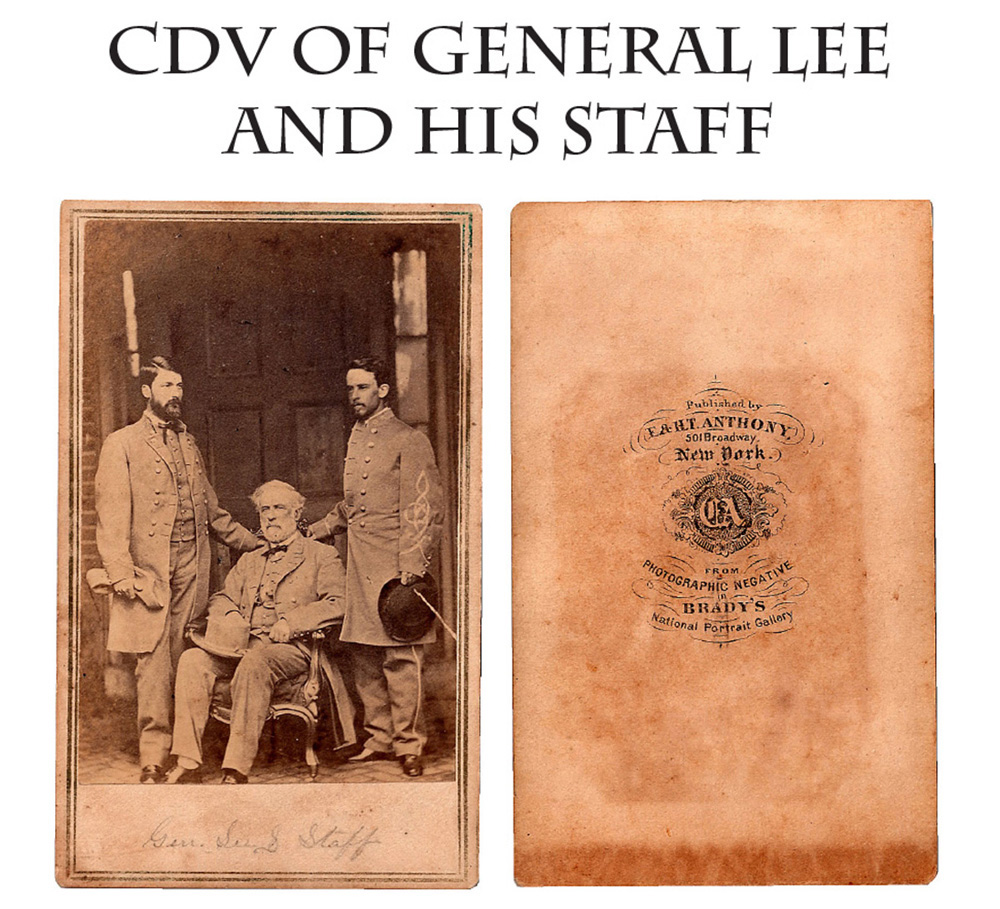
15-03-03 … CDV Robert E. Lee in Richmond:
On Left General George Washington Custis Lee (Lee’s Son), On right, Colonel Walter Taylor (Lee’s aid) April 20th, 1865. On April 16th, just days after Lee surrendered to Grant, he returned to his home in Richmond. He agreed to meet Mathew Brady four days later and Brady visited Robert E. Lee at his home at 707 E. Franklin Street in Richmond, and took six photographs of the vanquished rebel commander. In 1891 Brady recollected, “It was supposed that after his defeat it would be preposterous to ask him to sit, but I thought that to be the time for the historical picture. He allowed me to come to his house and photograph him on his back porch in several situations. Of course I had known him since the Mexican War when he was upon Gen. Scott’s staff, and my request was not as from an intruder, but it still took the co-operation of Mrs. Lee to have Robert’s photo taken.” One of the most significant Brady photos from the Civil War. And unlike many of Brady’s negatives … M.B. Brady himself took this Lee photo … a
… $1,950.00 – SOLD
Click Here to E-mail Us!
Call us @ 419-842-1863
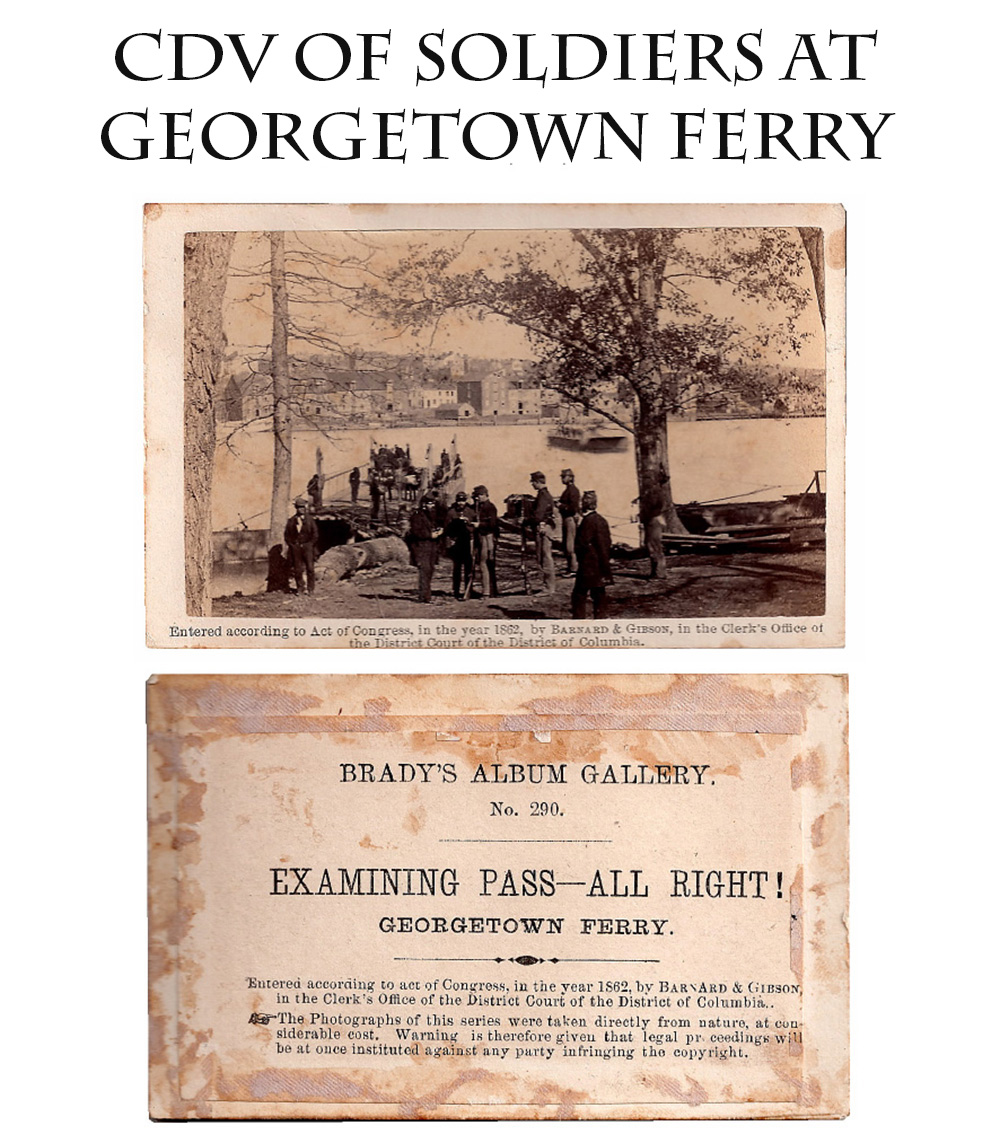
15-03-04 … 15-03-04 CDV Photo / Examining Passes At The Georgetown Ferry …
Brady’s Album Gallery card number 290 titled on the paper label on reverse: “Examining Passes- All right!” 1862 Barnard and Gibson photographer credit and copyright information. A nice view across the river, showing soldiers in the foreground reading passes and a ferry pulled up to the shore behind them with some passengers already aboard. Another vessel is midway across to their right rear. The soldiers have sometimes been identified as members of the 13th NY. Long saber bayonet scabbards are visible at their sides and the patchbox on what looks like an 1855 rifle is visible to the camera. Minor foxing spots to the edge of the card, not touching the albumen, which is very sharp. Some glue stains on the reverse from mounting in an album, but a nice full label. A heck of a great Civil War photo … bej
… $425.00 – SOLD
Click Here to E-mail Us!
Call us @ 419-842-1863
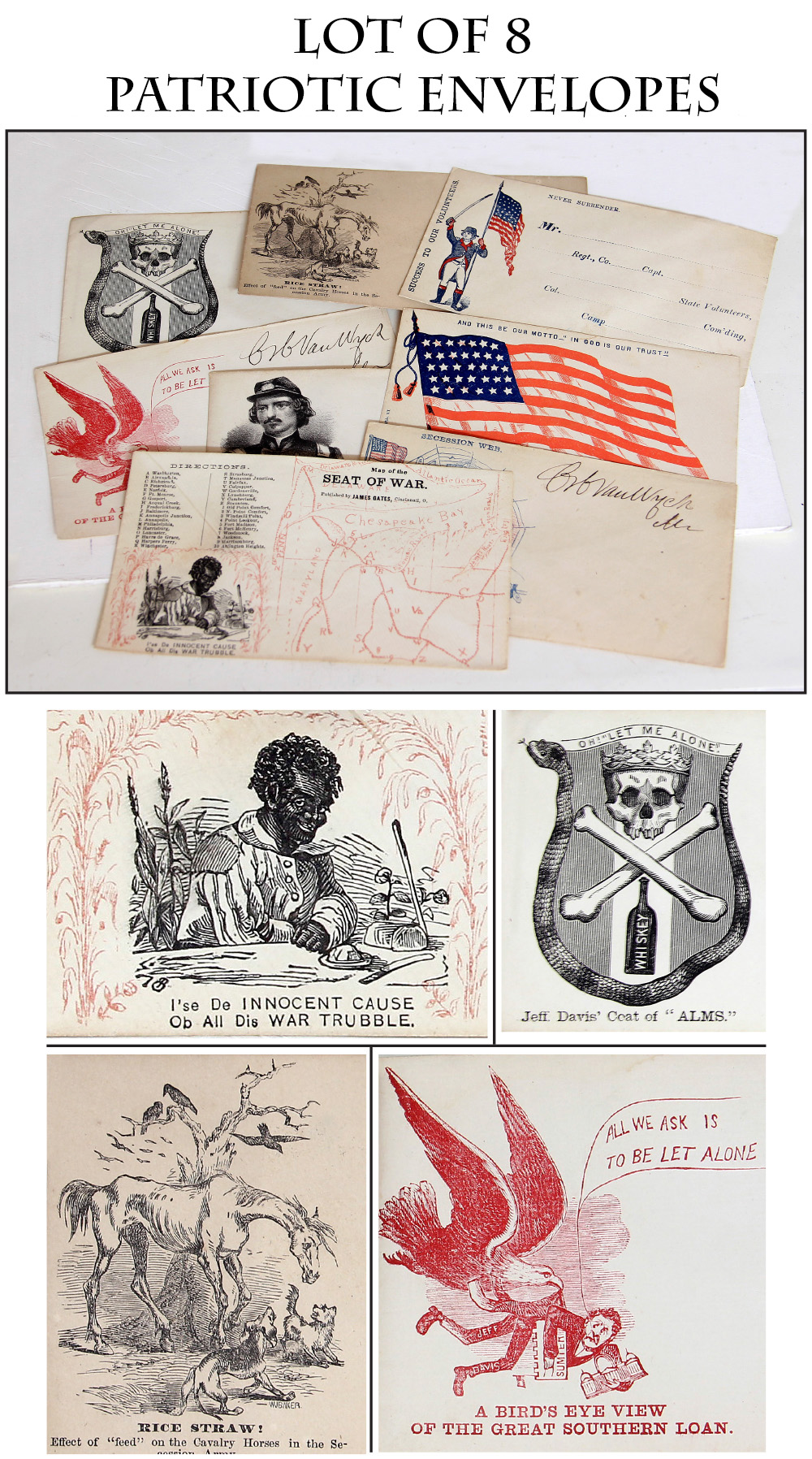
15-03-05 … Eight Patriotic Union Envelopes: Two Free Franked By Van Wyck …
vWonderfully colorful group of eight of these envelopes printed with satirical and patriotic designs. These were marketed and even collected during the war and were often accompanied by patriotic stationery as well. Two of ours are free-franked at the upper right: “CH Van Wyck, MC” (Charles H. Van Wyck, Member of Congress.) Van Wyck served in Congress from 1859 to 1863 (and again after the war.) He became Colonel of the 56th New York and was brevetted Brigadier General. A strong anti-slavery spokesman, he survived an assassination attempt in early 1861 that was reported as related to a speech he gave the year before denouncing it as a “crime against the laws of God and nature.” I once owned a large amount of 56th NY material including photos and documents of Col. VanWyck. I put these aside years ago because of the better than usual graphics and the historical connection. I just rediscovered them and figure I better list them now before I lose them again. A colorful set with some interesting history to boot!
… $125.00 – SOLD
Click Here to E-mail Us!
Call us @ 419-842-1863
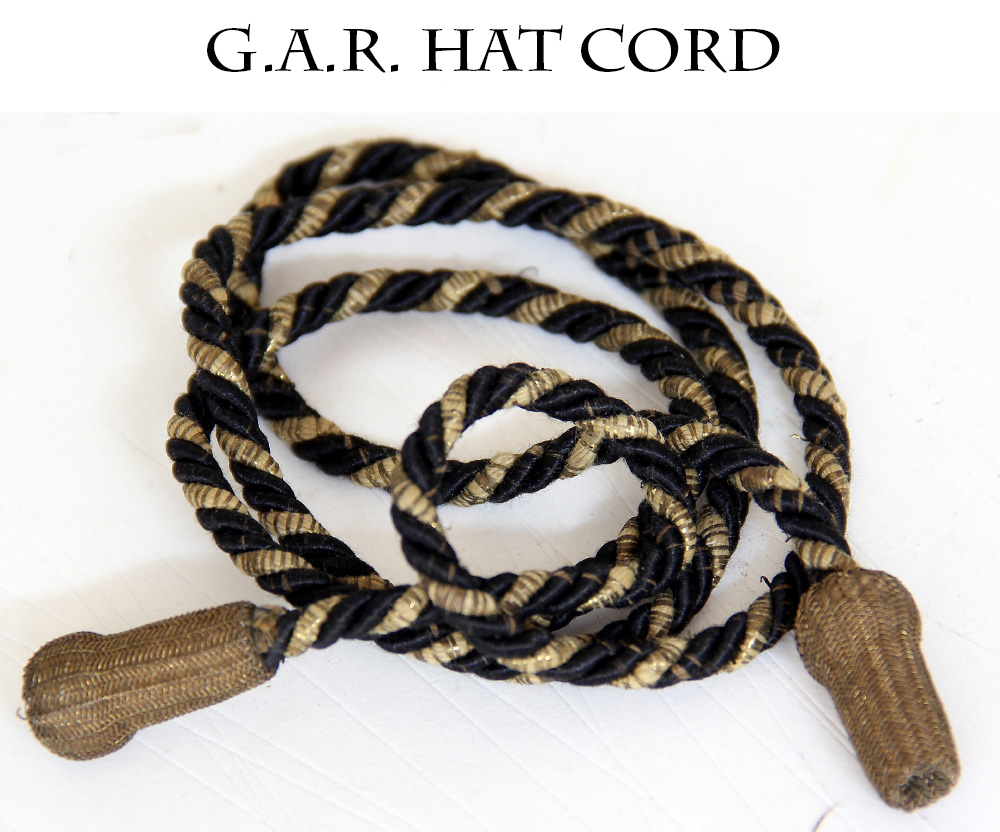
15-03-06 … Grand Army of the Republic Hat Cord …
Nice example of a Civil War veteran’s hat cord. Gold acorn ends, one of them slipped on backwards. Twisted black and white-with-gold-tape cord. These imitated the Civil War officer’s cords, but were worn by veterans of all ranks on their slouch hats. GAR memorabilia is a colorful offshoot in collecting Civil War material and offers tons of variety whether collecting by unit or locale. This would look great with a GAR hat insignia
… $39.00 – SOLD
Click Here to E-mail Us!
Call us @ 419-842-1863
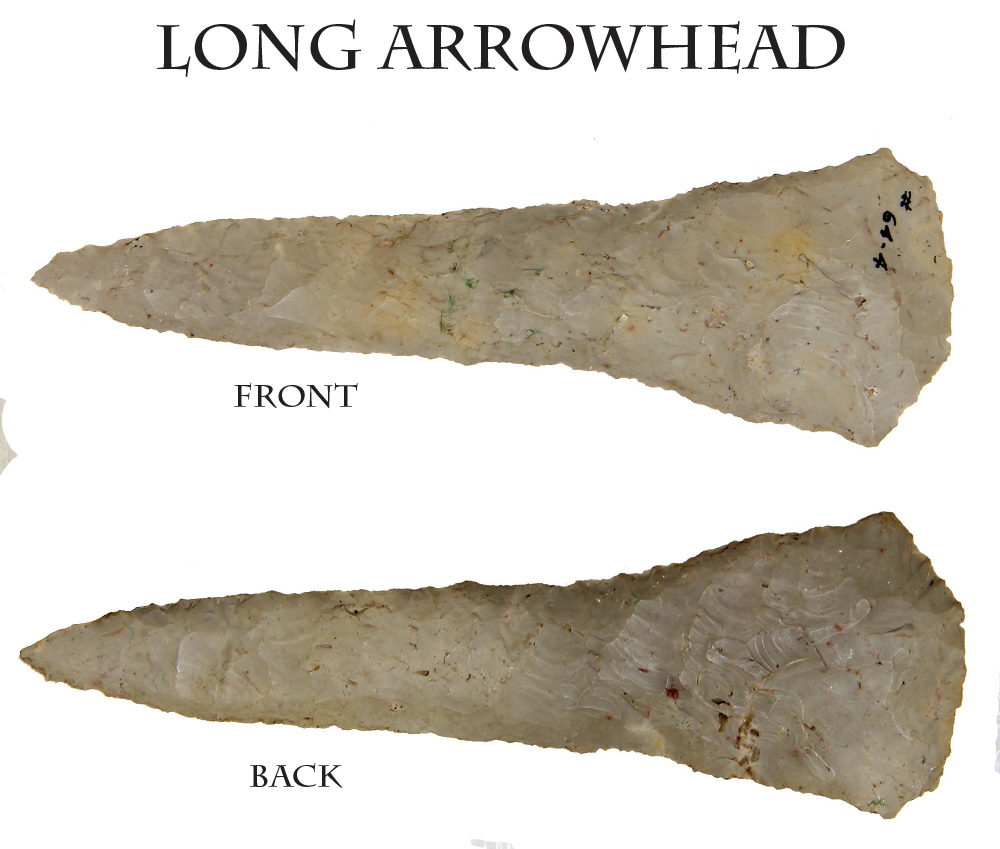
15-03-07 … Long Indian Arrowhead …
Either a large arrow – spear head or a stone knife blade. This must have come my way in some collection I bought years ago. I rediscovered it in a storage drawer and have no recollection from whence it came. Measures just shy of 5 1/2″ in length. Condition looks to be pretty good. These stone Indian Artifacts are WAY outside my area of expertise. I’m guessing, based on how long it is, a fair price is
… $125.00 – SOLD
Click Here to E-mail Us!
Call us @ 419-842-1863
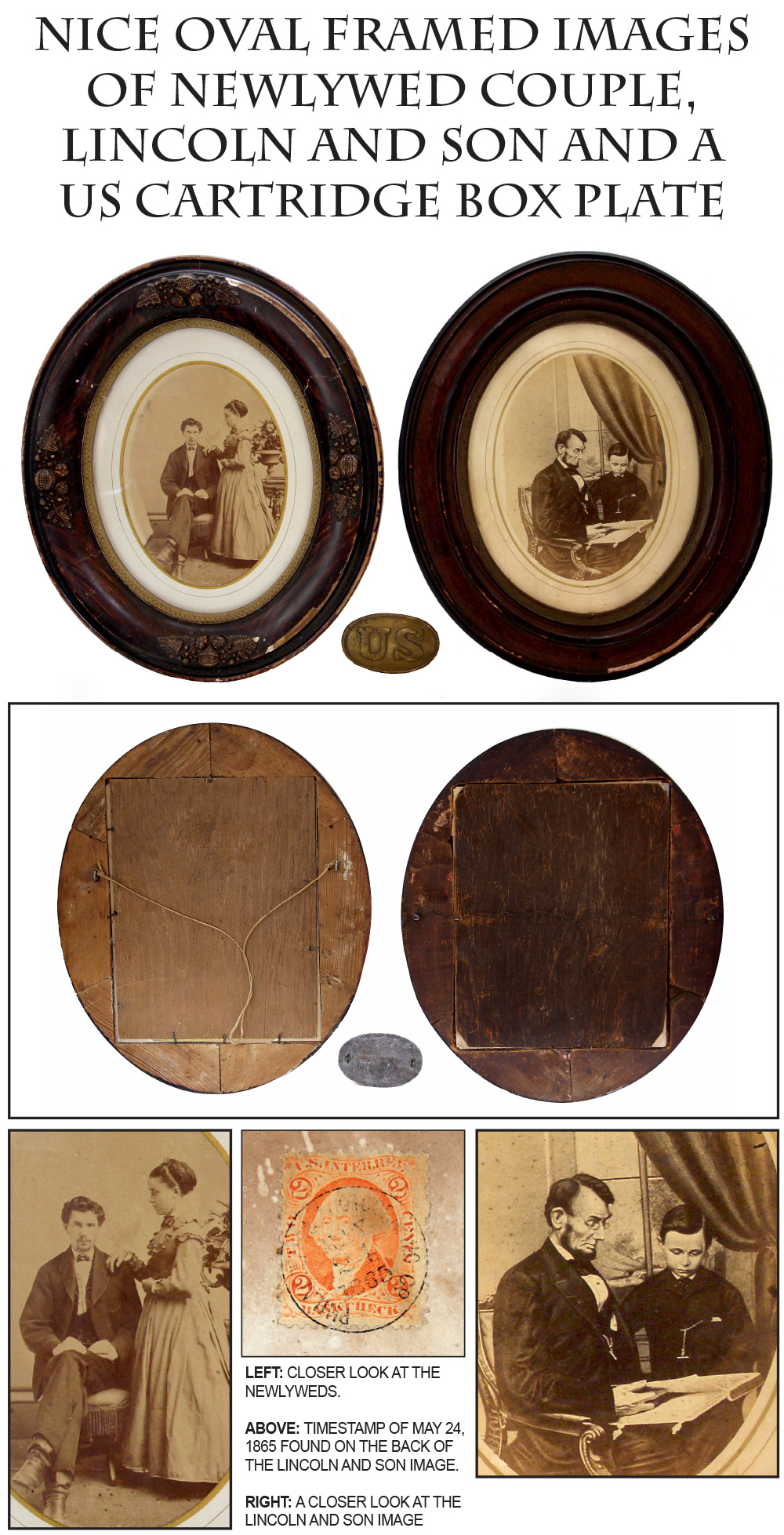
15-03-08 … Large Framed Newlywed Couple …
5 1/2″ x 7 1/2″ oval presented in a 12″ x 14″ 1860s oval frame. A fine Civil War era image just the way it hung on the young couple’s parlor wall 150
years ago. The bride looks to be about “4-foot nuthin” in terms of height. Neat portrait
… $59.00
15-03-09 … Large Framed Albumen Photo Lincoln and Son … ;
5 1/2″ x 7 1/2″ oval presented in a 12″ x 14″ oval frame. A richly toned and very handsome example of the famous view of Abe Lincoln and son Tad. What makes this specimen of particular note is the presence of a revenue stamp on the reverse with cancellation date. It is clearly stamped “May 24, 1865”. Just a scant month after the assassination when the country was still reeling. Much stronger tones and much richer contrast than usually encountered. A great Lincoln item in its original 1860s oval wall frame
… $125.00 – SOLD
15-03-10…Nice Condition US Box Plate …
Standard issue US oval cartridge box plate for the front flap of the infantry cartridge boxes. Excellent non-dug condition
… $195.00
Click Here to E-mail Us!
Call us @ 419-842-1863
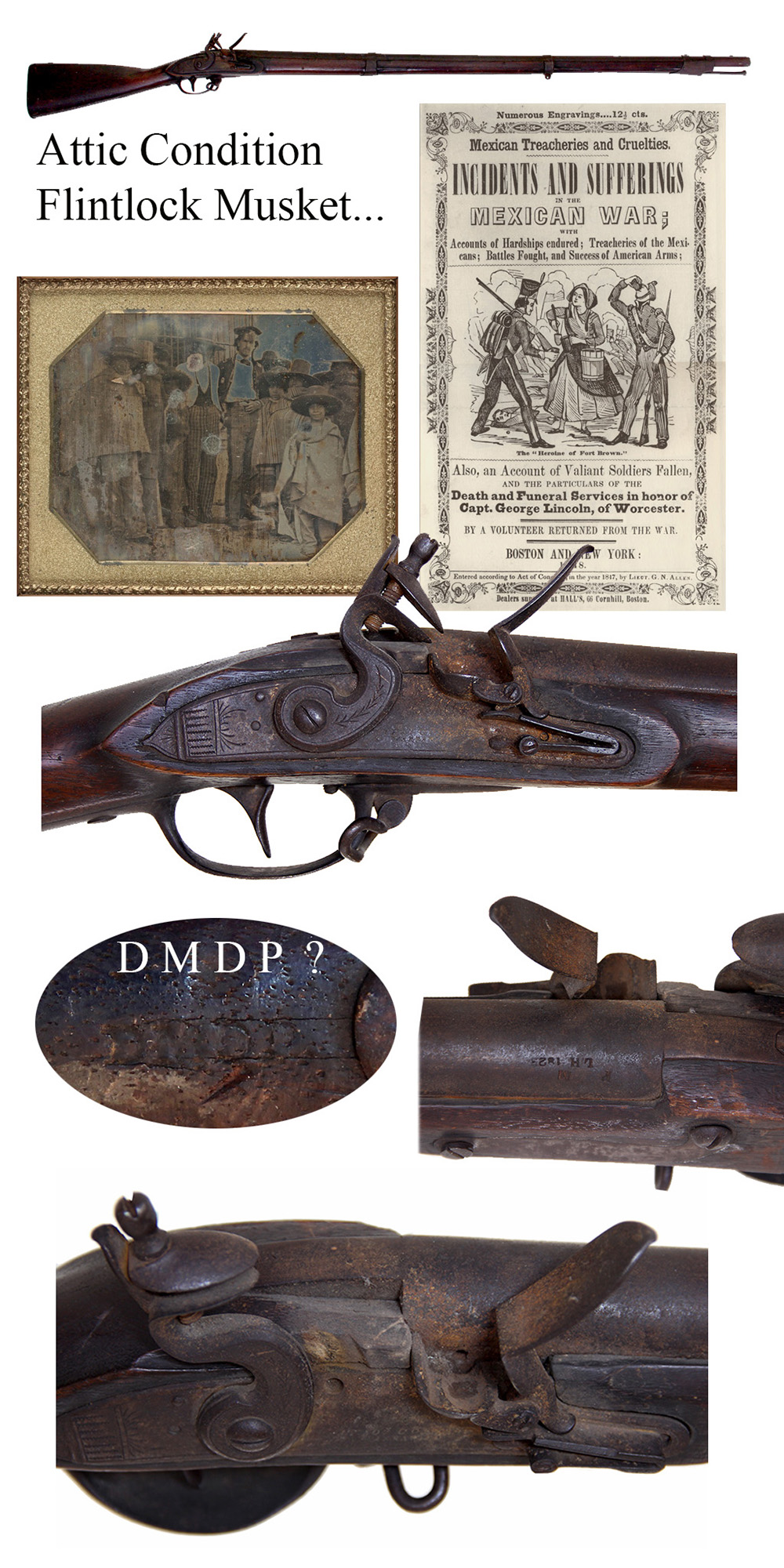
15-03-11 … Incredible Attic Untouched Flintlock Militia Musket:
Incredible Attic Untouched Flintlock Militia Musket: Fresh to the market is this glorious attic-dry Massachusetts flintlock militia musket. Absolutely “as found” condition… not oiled, never monkeyed with, 100% honest and untouched. The kind of condition you wish every historical item would be. The barrel is stamped “P. M. L. H. 1823.” The markings represent… PM = Proved Massachusetts. LH = Luke Harrington ( He was a state barrel prover in Worcester Mass.) , “1823” = The date of proving. Lock is marked “Thos. Cordis Warranted”. He was a London gun and parts maker late 18th through early 19th centuries. He and other English makers supplied many of the locks to Massachusetts makers for these muskets. On March 5th 1805 Massachusetts passed “An Act to Provide for the Proof of firearms manufactured within this Commonwealth.” This act required the barrels to be marked with P. M. as well as the inspector’s initials he act states in part “… said letters and figures shall be so deeply impressed … that (they) cannot be erased or disfigured, and shall be in the form following “P M”.
Until 1839 Massachusetts required the militiamen in the Commonwealth to procure their own muskets. This is as classic a specimen of such a militia musket as you could hope to find.
The guns are found in British design with pinned barrels and Springfield design with barrel bands. Ours is the latter. Overall length 57.5″ barrel length 41.75″ caliber .745.
Of some interest is a four character stamping in the wood behind the trigger guard tang which appears to read “D M D P”
meaning unknown, but I would wager the M stands for militia or Massachusetts. This musket is in Attic Fine condition. 100% original. 100% complete except for one missing sling swivel. This can be easily replaced but I have elected to leave this gem “as found”. Mechanically perfect.
Sliver of wood chipped out on the right side of the barrel tang. Negligible.
Original flintlock configuration, unaltered in any fashion from its time of use. Now nearly 200 years old this is one heck of a find. Priced about the same as a common Colt army or navy revolver but infinitely rarer and a whole lot older. Great Alamo Mexican War era flintlock, and Massachusetts did send one regiment to Mexico. As honest as they get
… $1,950.00 – SOLD
Click Here to E-mail Us!
Call us @ 419-842-1863
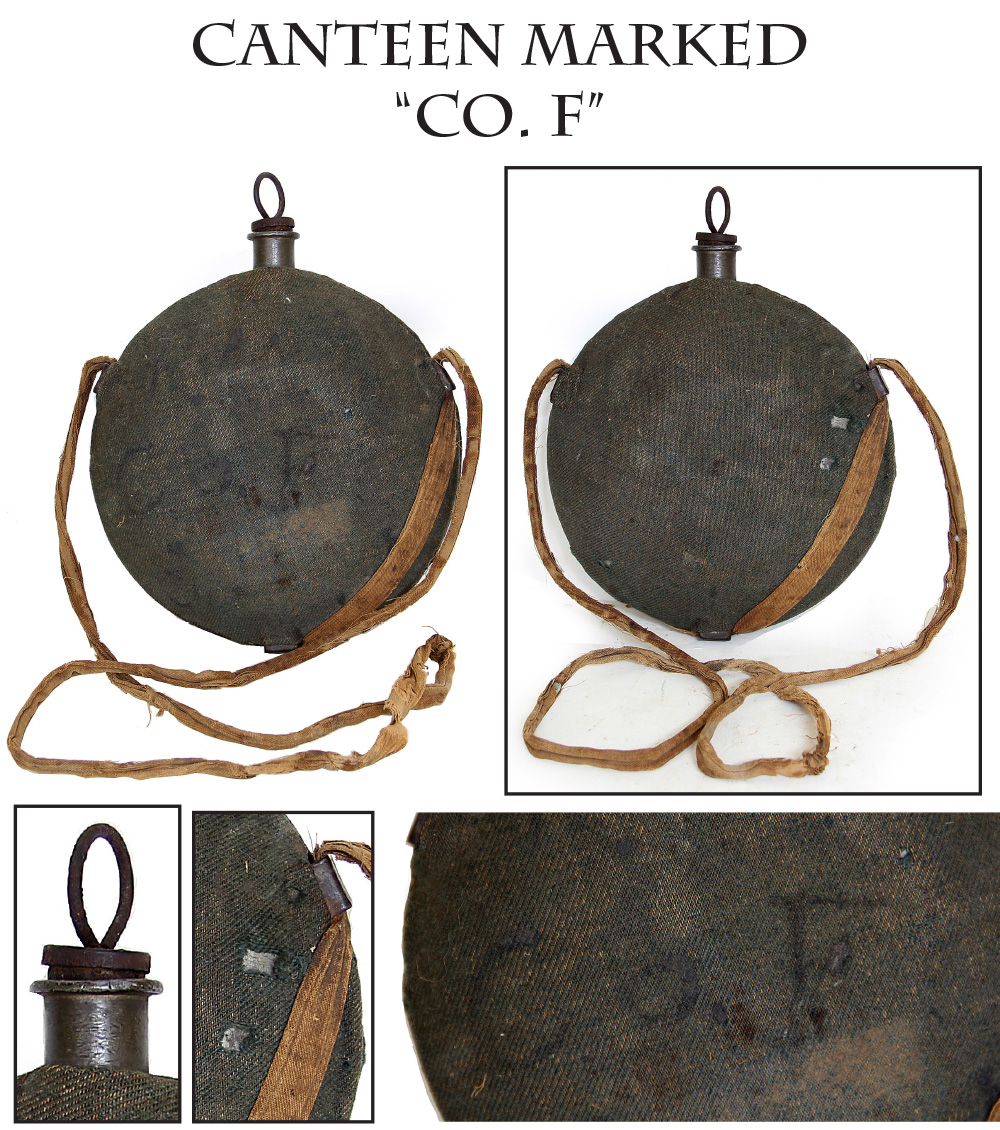
15-03-12 … Civil War Canteen With Company Marking …
A very scarce light-blue covered canteen, actually issued and used, showing only minor wear and with an original soldier’s marking in old ink “Co. F” on the cover. Above this is an even fainter set of initials. The linen sling shows some fraying and tears, but is still in one piece. You can see where the soldier knotted it at some point to make it ride higher at his side, or hang it up after the war. The original stopper is still with it, though the cord retaining it was long ago lost. The cover is very good, with just two small holes on the side opposite the company markings, near the upper bracket on the right. Depots and contractors supplied canteens with a wide variety of colored covers. The most common are the gray/brown, the dark and light blue being considerably scarcer, and the light blue being always sought after as the “regulation” color. A very solid example, with good color and great evidence of issue and field use … xxczz
… $450.00 – SOLD
Click Here to E-mail Us!
Call us @ 419-842-1863
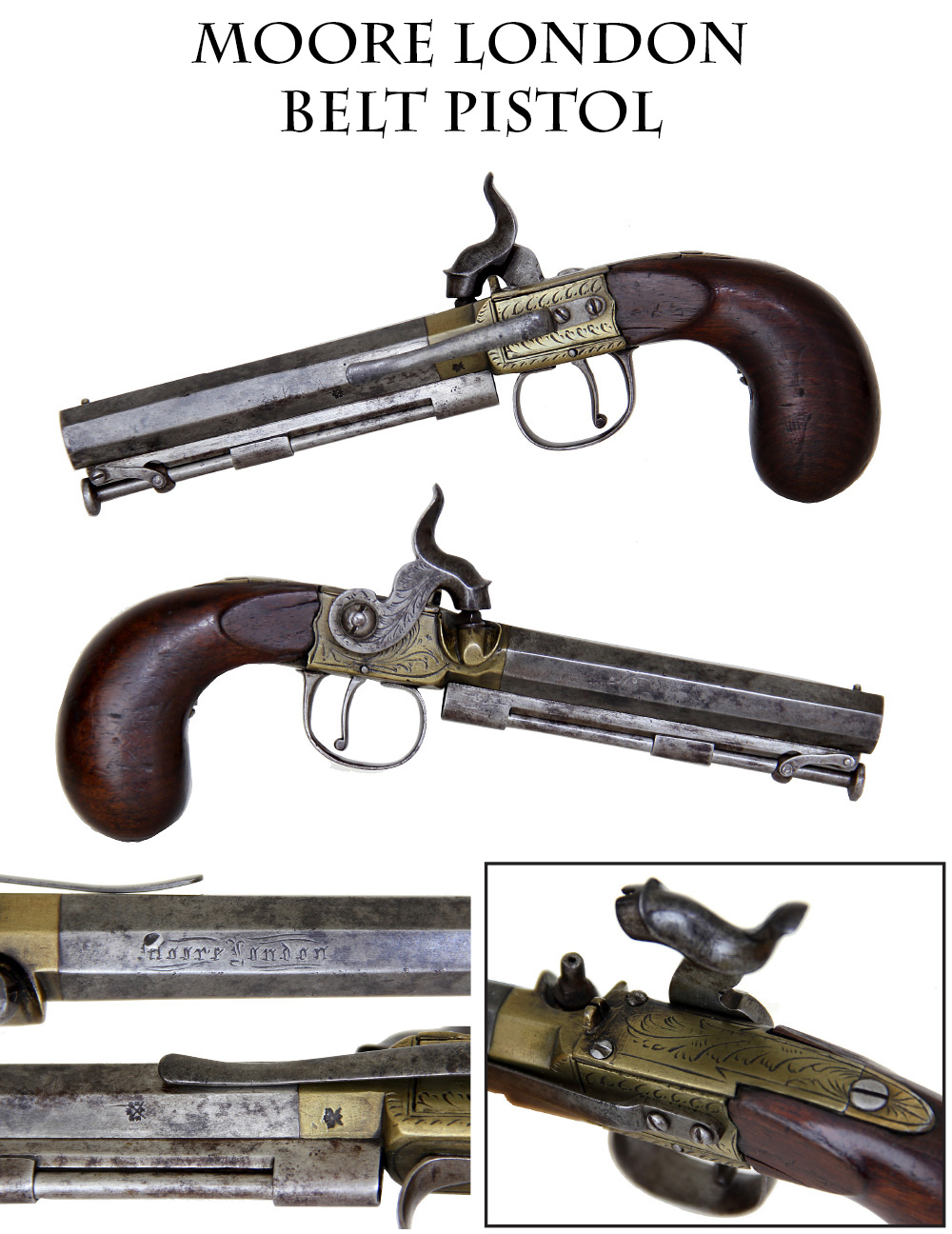
15-03-13 … Moore London Belt Pistol …
Charles Moore of London .45 Cal Percussion Cap & Ball Pistol Circa 1845. 8.25 inches overall. Bird’s head grip. Brass frame is nicely hand engraved with feather like flourishes as is the steel trigger guard and hammer. Steel octagonal barrel and steel rod with capture swivel are firmly in place. 4 inch barrel is signed “Moore London” on the top flat. Left side has a spring steel belt hook secured with two screws. Overall VG condition. Mechanically VG. Small crack at the tang screw where the frame secures to the grip. About the size of a Colt pocket revolver. This large bore pistol would have packed a wallop for sure. Hang it from your belt, waist band, or commerbund and you are ready for a big night out in Jolly Old England in the days of highway men and pickpockets
… $595.00 – SOLD
Click Here to E-mail Us!
Call us @ 419-842-1863
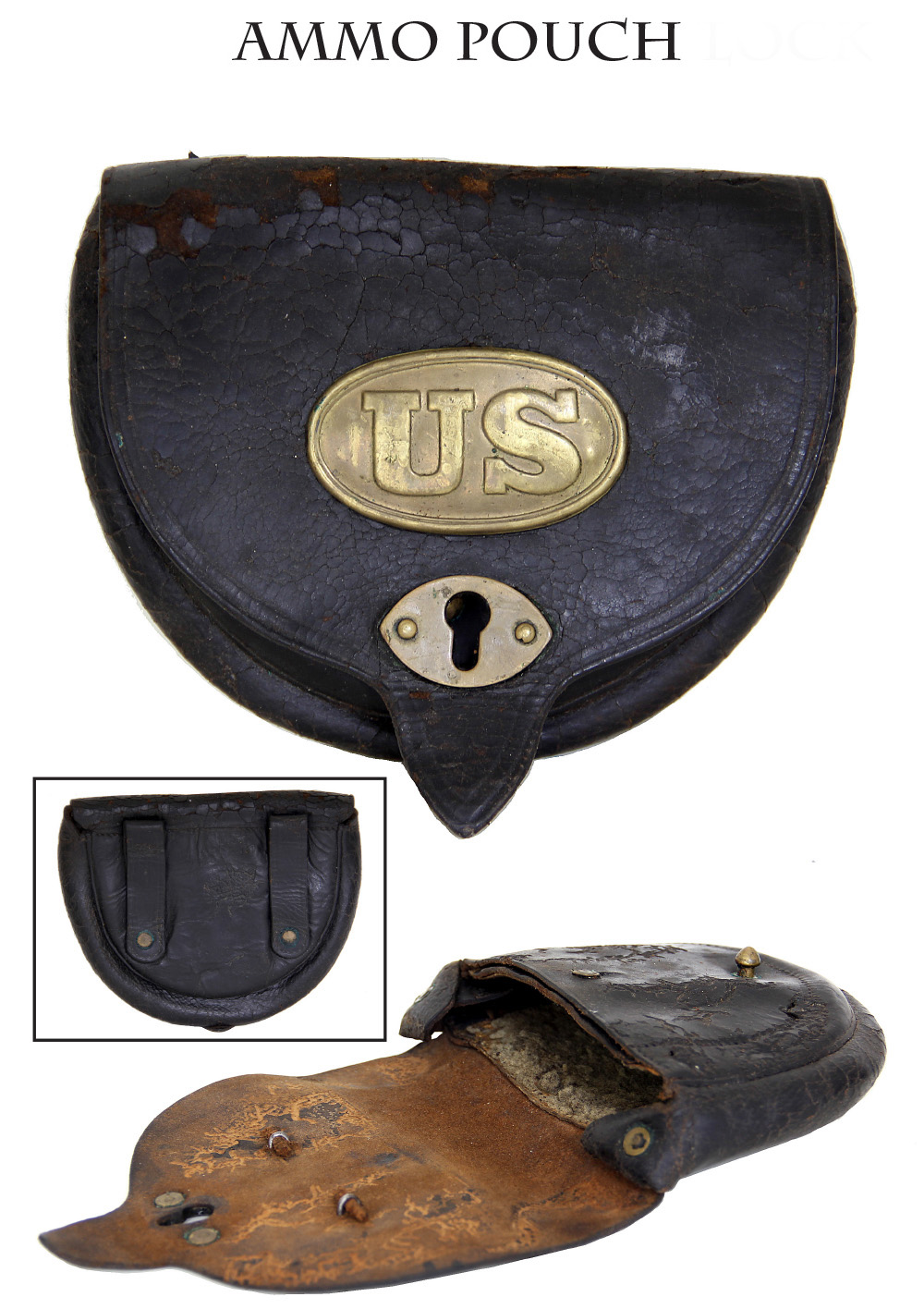
15-03-14 … First Pattern 1874 Dyer Carbine Cartridge Box With A Civil War US Plate:
These fleece-lined pouches were issued to Custer era Indian War U.S. cavalry for their .45 caliber cartridges. Intended to hold 40 rounds, they likely held somewhat fewer. At the upper corners two ears are supposed to help prevent the cartridges from bouncing out, and a separate front pocket with a button closure was designed for the combination screwdriver tool. Two belt loops on the reverse are secured by stitching and rivets. The key to identifying the box is the use of the horizontally mounted keyhole escutcheon plate designed to engage the front stud on the box and keep it fastened. In 1874 this was one of several patterns tested in the field, and was the one preferred by a number of 7th Cavalry officers who would later die at the Little Big Horn. A number of collectors and students of the battle think that in addition to field made prairie belts, many of the troopers that day carried this pattern box into action. In any case, this is a nice example and shows a very cool period addition that would be typical of Civil War veteran serving in the postwar army: someone has taken a small-sized CW cartridge box plate and affixed to the front over the embossed US on the cover, and secured it on the inside with two thongs. It’s not only a reminder of the wartime style, but a practical measure to ensure the box stays closed when full, something the brass keyhole escutcheon was meant to deal with as well. The Civil War plate is easily worth 250 to 300 by itself. Price for the Custer box and CW plate together … bhhp-cow
… $350.00 – SOLD
Click Here to E-mail Us!
Call us @ 419-842-1863
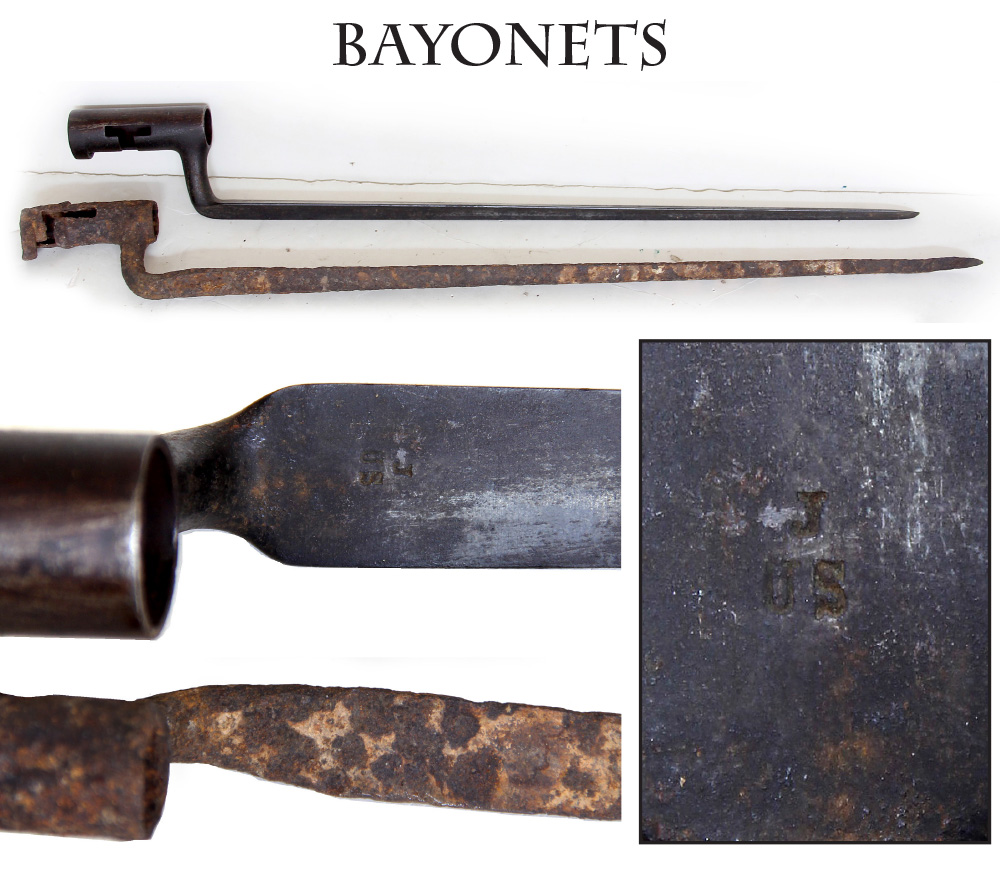
15-03-15 … US Model 1816 Bayonet Nicely Marked:
Standard M-1816 socket bayonet deeply stamped with an inspector’s initial J over the US stamp. Condition VG to fine. Smooth steel blade. Entire bayonet has smooth deep brown and plum patina… very attractive. Some light surface pitting on one section of the socket only. Balance smooth. Has tiny stamp E over 33 on the elbow … ex sorg
… $165.00 – SOLD
15-03-16 … Relic 45/70 Trapdoor Bayonet …
A dug-up (out of the ground) Springfield bayonet for the 1873 trapdoor. Typical rusty, crusty, dug-relic condition. Lacks locking ring. No idea where it was found. I got it in a big collection of eclectic
stuff
when an old Toledo collector died and his brother sold me the whole kit and kaboodle. Great Indian War relic Perfect for Wild West display … and cheap
… $25.00 – SOLD
Click Here to E-mail Us!
Call us @ 419-842-1863
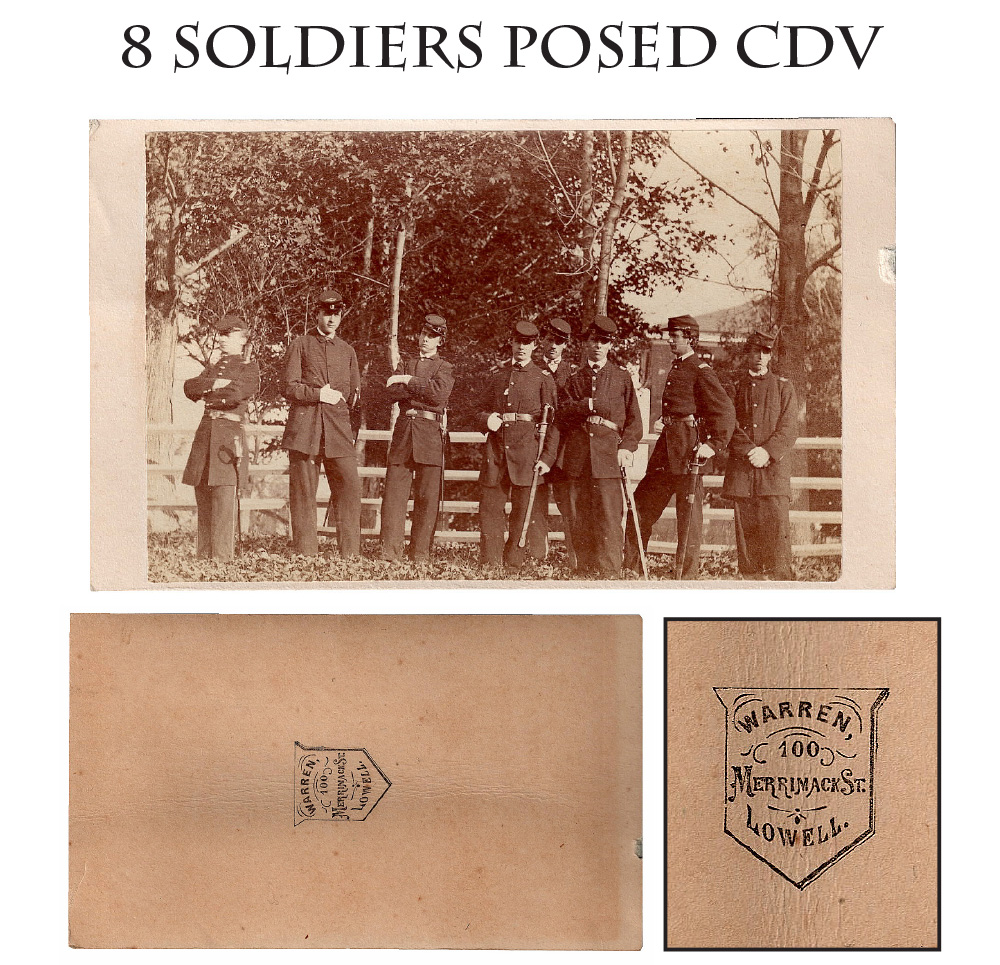
15-03-17 … Eight New England men are posed in front of a rail fence in a variety of poses.
Off to war? Home from war? State home guards who missed the war? All appear young and we might in fact be looking at a local militia group. Six wear officers’ frock coats or undress sack coats, all with shoulder straps. The officer at left, looking off to the left in a disinterested fashion, has a foot officers sword belted to his side, as do at least three of the others. Two taller soldiers, numbers two and three from the left, may be NCOs or musicians. One wears an infantry bugle on the top of his forage cap and seems to carry an NCO sword. His companion looks to have a musician’s pattern sword on a waistbelt with an oval US plate. The other plates visible are the standard 1851 patterns. All in all, a very nicely posed outdoor photograph. Warren, 100 Merrimack St., Lowell (Mass., I presume) backmark. No tax stamp … ajjxx
… $185.00 – SOLD
Click Here to E-mail Us!
Call us @ 419-842-1863

15-03-18 … CDV Photo Standing View / Drummer Boy of the 103rd Ohio Volunteers:
Truly spectacular standing view of the 103rd OVI regiment’s drummer. Note the companion CDV of the same drummer which shows the painted face of the drum. That seated view photo shows the painted design where can be clearly seen “103rd Ohio” in the ribbon at the top of the drum. A companion drum resides in the museum of the 103rd Ohio in Sheffield Lake, Ohio. Read the description of the seated view CDV for more history. Here is a short history of the regiment…
This regiment was organized in the state at large in Aug. and Sept., 1862 to serve for three years. Its first year of service was spent in Kentucky, but in the fall of 1863 it was ordered to eastern Tennessee, where in its first engagement, at Blue Springs, it lost 3 killed, 4 wounded, and 6 taken prisoners. During the siege of Knoxville the regiment lost about 35 in killed and wounded. In May, 1864, it formed part of Sherman’s grand army and in the engagement at Resaca lost over one-third of its effective force. The regiment lost heavily during the Atlanta campaign. On May 1 its effective force numbered 450 men, but when Atlanta had fallen it could only muster 195. It followed Hood to Tennessee and had another opportunity of showing its pluck at the battle of Spring Hill. After Hood had been driven from Nashville the regiment went to North Carolina, thence to Ohio, and was mustered out on June 12, 1865. A rare and visually exciting piece of photgraphic history
… $1,350.00
—————
15-03-19 … CDV Photo Seated View Drummer Boy of the 103rd Ohio Volunteers:
Truly spectacular seated view of the 103rd OVI regiment’s drummer. This view shows the painted face of the drum, where can be clearly read “103d Ohio” in the ribbon at the top of the drum. A companion drum nearly identical resides in the museum of the 103rd Ohio in Sheffield Lake, Ohio. See above for photos of the drum displayed there. It is virtually identical except for some miniscule differences in the lettering. Either the 103rd had two or more drums painted nearly identically for their musicians, or the drum in the museum was repainted later and is the same one shown in the CDV photo. I personally believe they had two or more drums. Also shown above is a reunion photo where our drummer boy is clearly shown in the center of the older veterans. He is older in the 1880s photo but the facial features are unmistakable. I am certain the drum at his feet is the one shown in the CDV. Here is a short history of the regiment…
This regiment was organized in the state at large in Aug. and Sept., 1862 to serve for three years. Its first year of service was spent in Kentucky, but in the fall of 1863 it was ordered to eastern Tennessee, where in its first engagement, at Blue Springs, it lost 3 killed, 4 wounded, and 6 taken prisoners. During the siege of Knoxville the regiment lost about 35 in killed and wounded. In May, 1864, it formed part of Sherman’s grand army and in the engagement at Resaca lost over one-third of its effective force. The regiment lost heavily during the Atlanta campaign. On May 1 its effective force numbered 450 men, but when Atlanta had fallen it could only muster 195. It followed Hood to Tennessee and had another opportunity of showing its pluck at the battle of Spring Hill. After Hood had been driven from Nashville the regiment went to North Carolina, thence to Ohio, and was mustered out on June 12, 1865. Our CDV photo is a rare and visually exciting piece of photographic history. There are but a handful of photos of CW drummers where the unit ID can be clearly seen in the photos. The best I have owned in 43 years of collecting
… $2,250.00
Click Here to E-mail Us!
Call us @ 419-842-1863
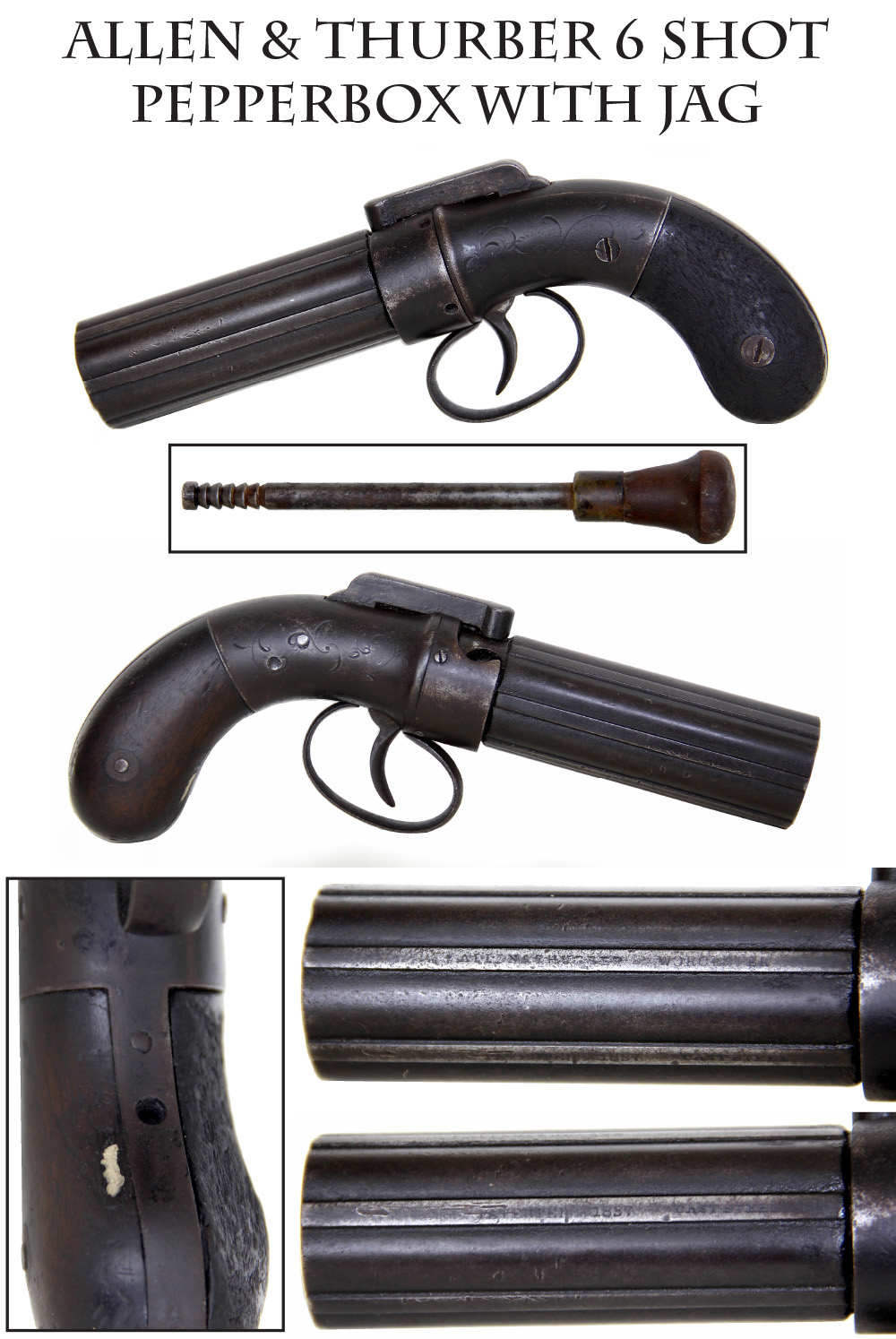
15-03-20 … Allen & Thurber 6 Shot Pepperbox with Cleaning Jag:
A very good example of the 1840s era Pepperbox pistol. Incorporates six barrels measuring 3.5 inches. Overall length of the pistol is about 8 inches. Standard walnut bag grip. Left side of grip shows charring from being too near a fire or stove. Barrels signed “Allen & Hopkins Worcester Patented 1837 Cast Steel”. Metal overall dark patina. Mechanically VG. Comes with a nice wood handled cleaning jag
… $635.00
(If you don’t want the jag deduct $25)
– SOLD
Click Here to E-mail Us!
Call us @ 419-842-1863
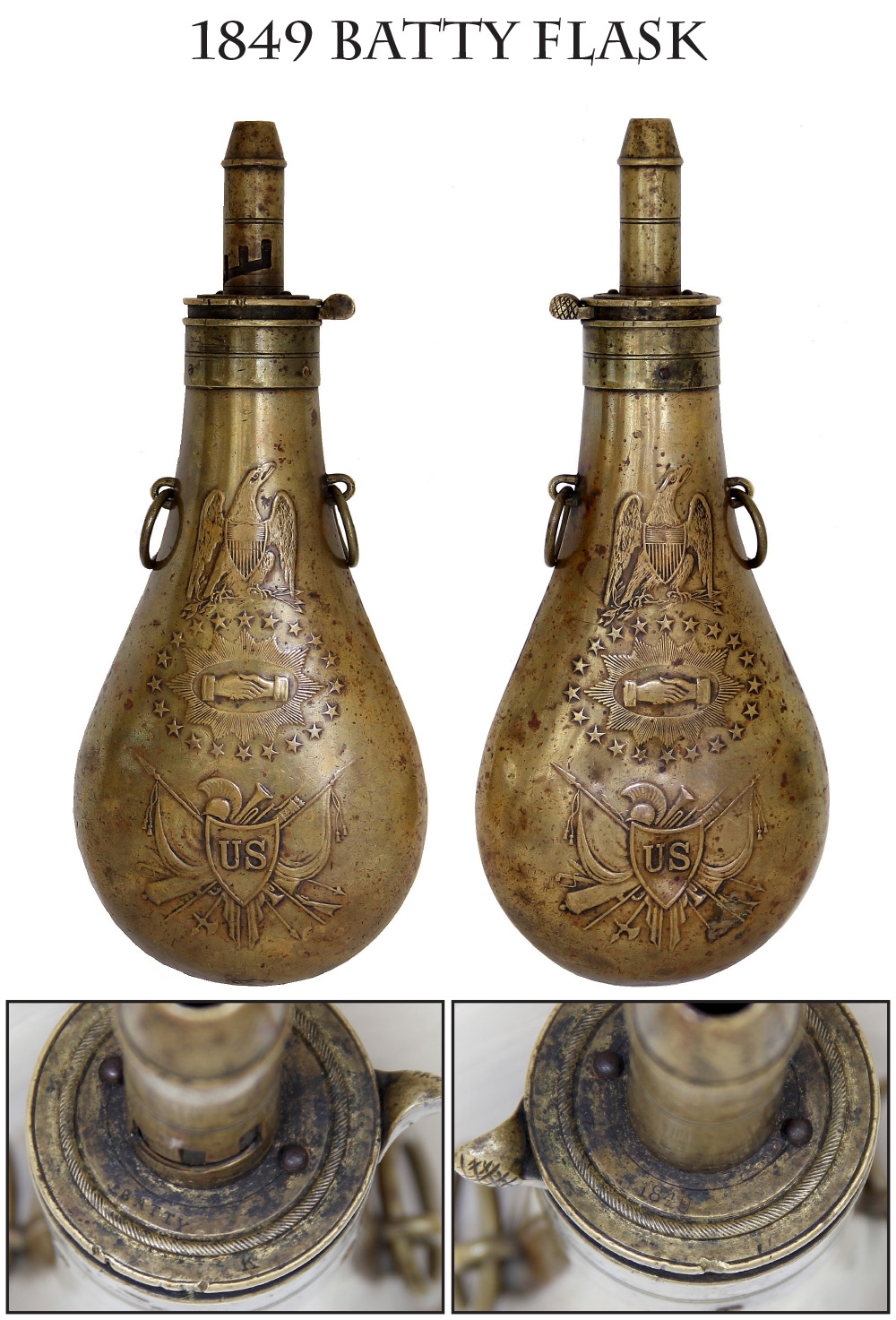
15-03-21 … 1849 Dated Brass Batty “Peace Flask” …
One of the most attractive of all embossed flasks. An American eagle perches on arrows and olive branch above an oval of stars that surround a pair of clasped hands within a sunburst. Below is a US on a shield which overlays a trophy of arms, instruments, helmet, and banners. Both carrying rings are in place, as is the adjustable spout. Thumb piece and spring in place and functional, very clear BATTY maker’s mark and 1849 date on the flat top. Known as the “peace” flask from the clasped hands, the original significance was more likely faithfulness or fidelity, but it’s a striking design. Some wear to the highpoints from actual use, a little more on one side from rubbing against the body, as we should expect. Medium patina with some scattered dark spots, but no dents or separation lines. A very nice flask dating just after the end of the Mexican War and to the beginning of expansion into the west. A good early martial and frontier piece
… $485.00 – SOLD
Click Here to E-mail Us!
Call us @ 419-842-1863
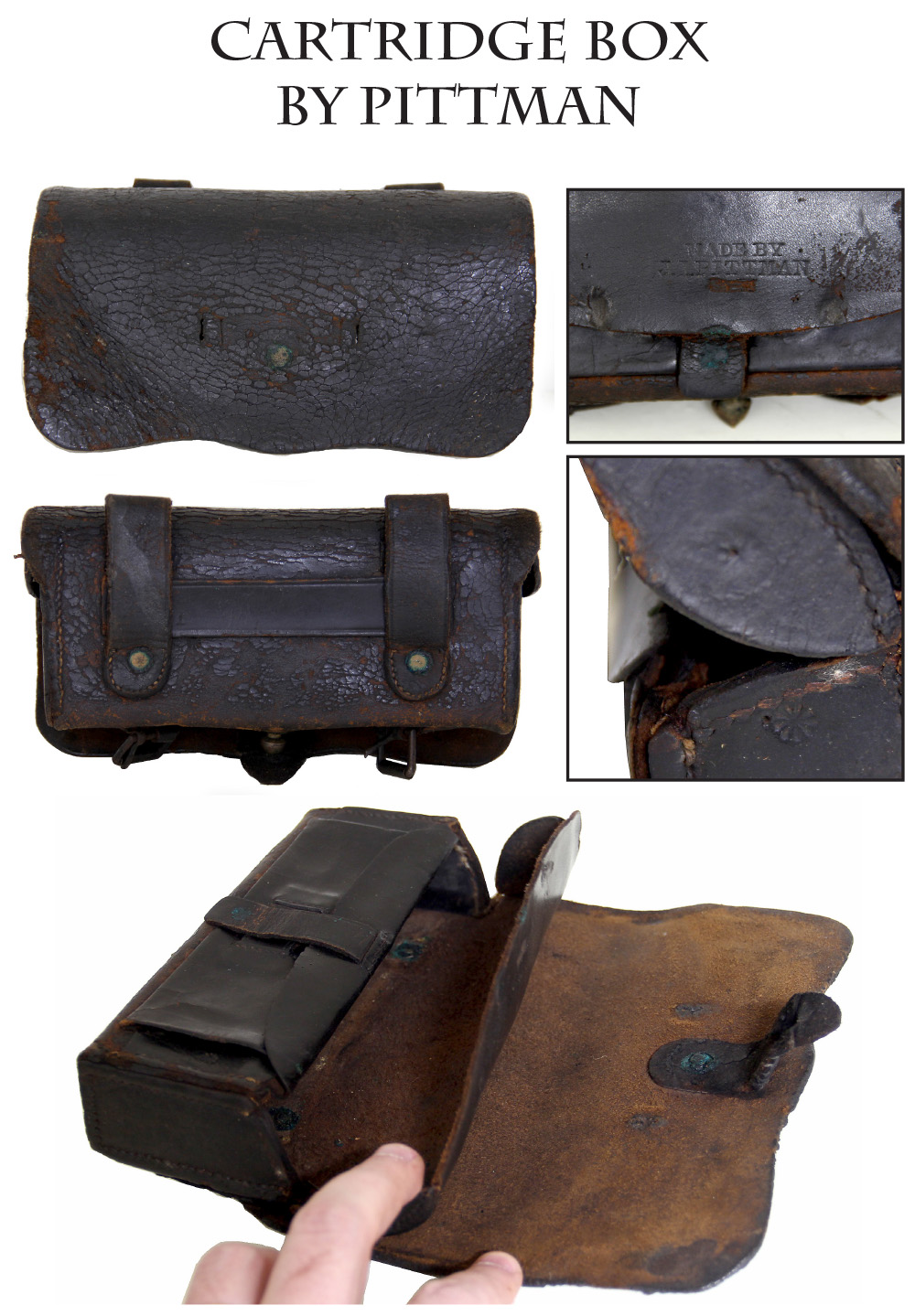
15-03-22 … Civil War Cavalry Cartridge Box By Pittman …
Regulation issue piece of gear for the Civil War cavalryman. A representative example with latch tab, implement pouch, and all buckles and straps in place. The latch tab has been repaired. These were issued with a wood block bored out to accommodate the particular caliber of cartridge used by a trooper. This one is missing that block, either because it was the wrong caliber or the trooper or a subsequent owner preferred to carry his cartridges loose. Still, it is a nice solid example with a clear Pittman maker’s stamp, who had a number of US contracts. The latch tab is in place and secured by semicircle of stitching and a rivet. There is some stitched repair thereon. This box preserves the older design of not only belt loops but buckles and a retaining strap for a shoulder sling, which was almost never used as far as anyone can tell- the box being worn on the saber belt and occasionally the carbine sling. Typical alligatoring and crackling to the finish from flexing and use. This one also shows it was actually issued and worn – two narrow slights in the cover show where a soldier decided to add a cartridge box plate to the cover- a bit of non-regulation field modification that probably looked good, had the advantage of keeping the cover down if he had unlatched it. A key cavalry piece with a lot of variations for the collector. Priced extra friendly
… $185.00
Click Here to E-mail Us!
Call us @ 419-842-1863
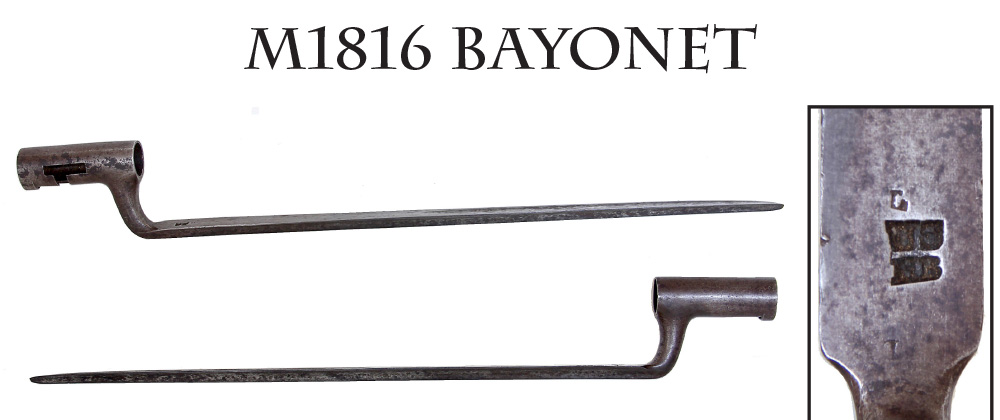
15-03-23 … 1816 Pattern US Bayonet …
The 1816 pattern muskets were produced over a long period and many were altered to percussion, finding their way in the hands of the army and militia, and back into the field for use against one another in the Civil War. Here’s a nicely marked example, showing the characteristic T-slot used before the introduction of the locking ring. Marked with two “L” stamps and a “US” over “HB” between. Medium gray patina with some darker gray areas, but a nice clean, smooth example
… $165.00 SOLD
Click Here to E-mail Us!
Call us @ 419-842-1863
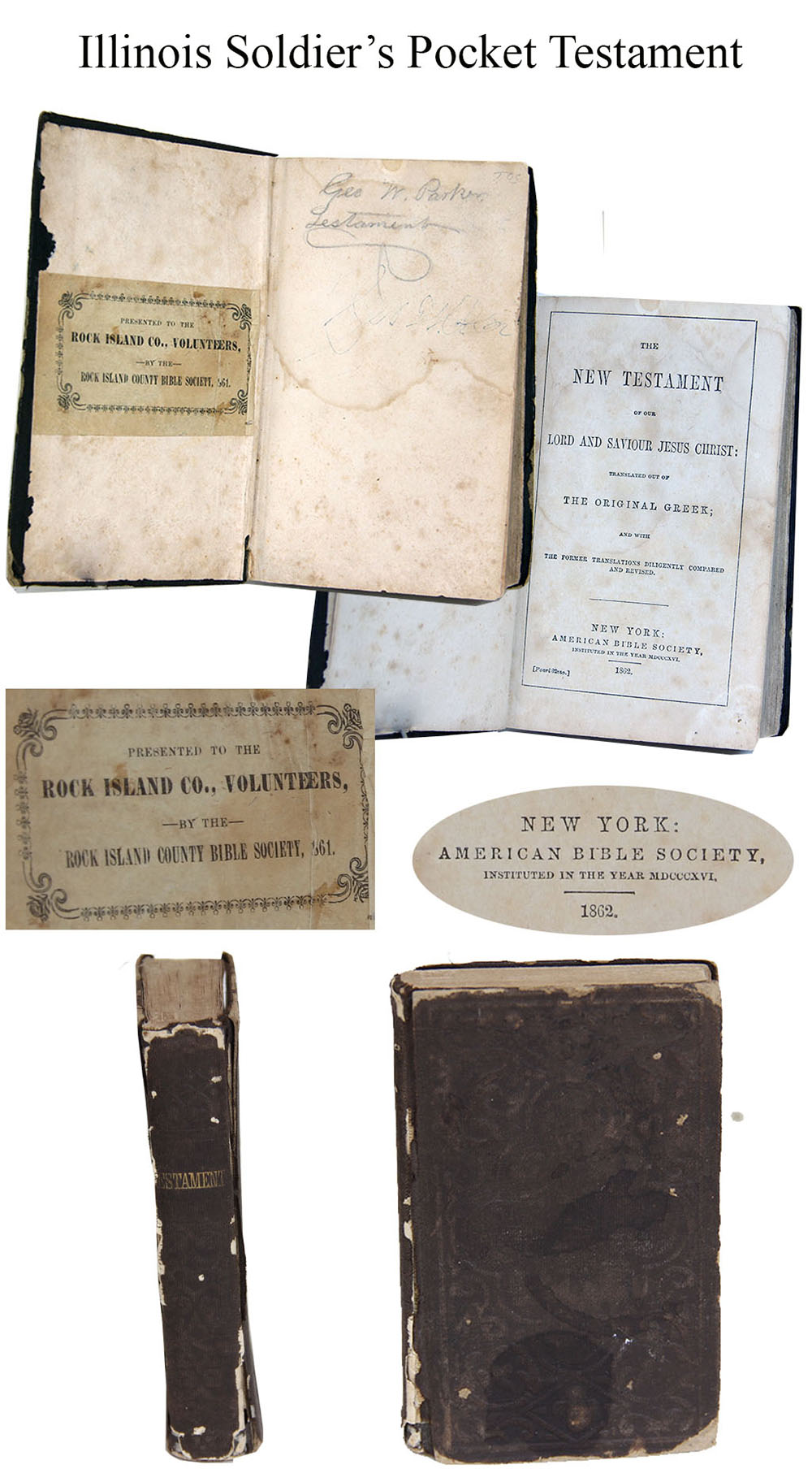
15-03-24 … 126th Illinois Soldier’s Pocket Testament w/ Rock Island Volunteers Label:
A classic and standard size pocket New Testament printed in 1862 with very interesting label and inscription inside. Inside the front cover is a printed label relating to the Rock Island Volunteers and Rock Island Bible Society. It is the first Rock Island label I have encountered. On the fly leaf is the owners name “G.W. Parker”. Research on this one was straight forward. There are 28 soldiers named G. Parker from Illinois. Of the 28 only one was from Rock Island County. He was sergeant George W. Parker of Coal Valley, Rock Island County, Illinois. He served from September 1862 through February 1865, being commissioned Lieutenant on Sept. 1st 1863. The regiment served in the Dept of Tennessee and the Dept of Arkansas. It took casualties at Devall’s Bluff, Arkansas and Jacksonport Alabama. Finding western theater personal items is much rarer than finding items from the more populous eastern states. A great Illinois relic
… $235.00 – SOLD
Click Here to E-mail Us!
Call us @ 419-842-1863
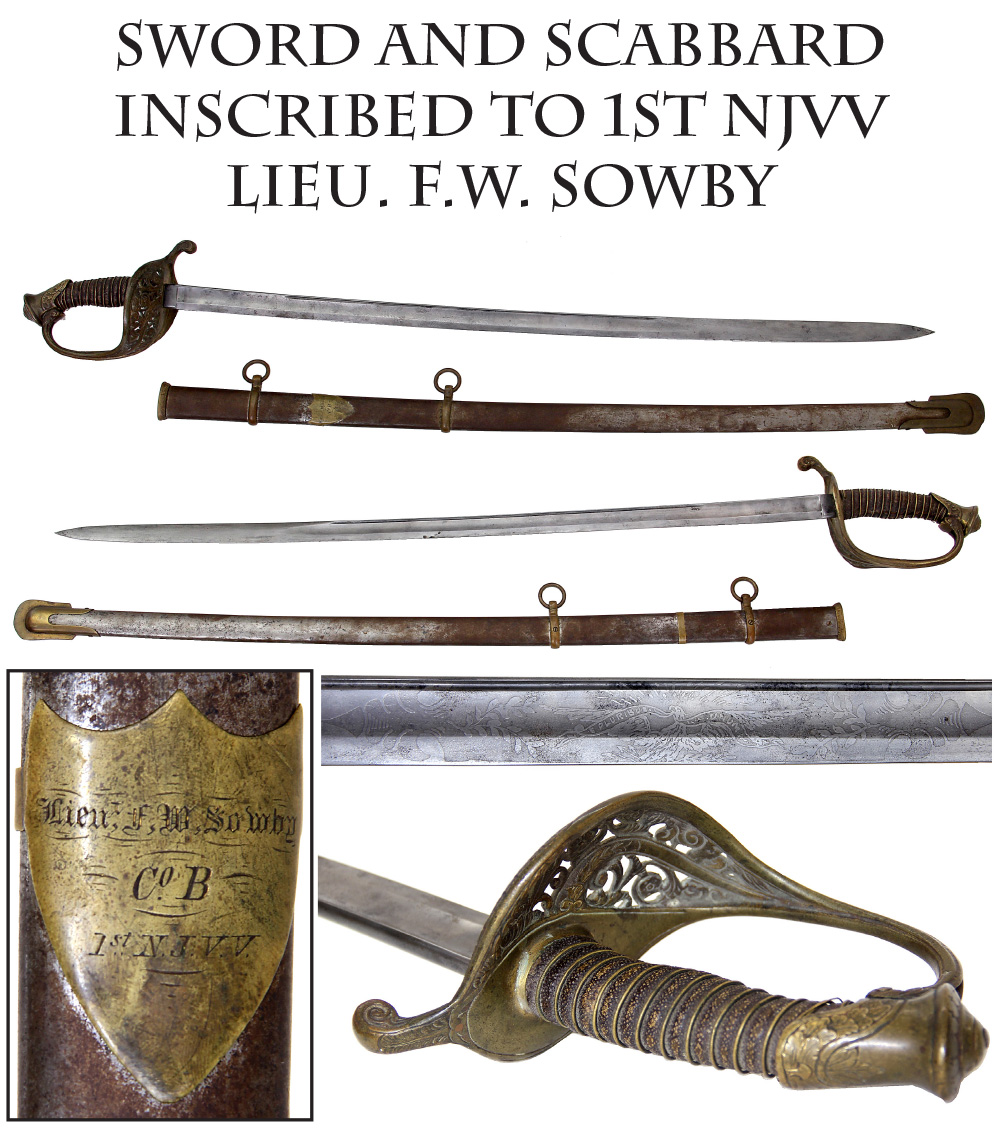
15-03-25 … New Jesey Inscribed Officer’s Sword:
1850 pattern foot officer’s sword in a brass mounted steel scabbard. Matching mellow patina to all the brass- untouched with some dark areas. Down-turned pommel that suggests Sauerbier as a maker or dealer, but has a stopped fuller and sharkskin grip. Grip good with just wear and rubbing to high spots from use. Single thick wire binding, one small piece of a thinner bordering wire near the pommel. Scabbard silver gray turned brown for about two thirds the length. Brass throat, carrying rings and drag in place. Between the upper mounts is a separate brass shield shaped plaque held by a band, nicely inscribed: “Lieut. F. W. Sowby / Co. B / 1st N.J. V.V.” in Old English and block letters.
CWData shows two men named F.W. Sowby, but there was only one, serving in the 3rd New Jersey, and then joining the 1st New Jersey Veteran Battalion (or “1st NJ Veteran Volunteers”) which consisted of the consolidated units. Sowby enlisted in the 3rd NJ in April or May of 1861, mustering in as a private in Company B and making corporal as of July 1, 1863. He served with them until 6/23/64 when he and the others who had reenlisted as veterans or had time left to serve were transferred and he joined Company B of the 1st NJ. He was commissioned 2nd Lieutenant 2/2/65 and 1st Lieutenant 5/11/65, mustering out 6/29/65. Sowby would have seen a lot of action. Both units were Army of the Potomac, 1st and 6th Corps. The 3rd, in particular, took heavy casualties at Gaines Mill, Cramptons Gap, Salem Heights, and Spottsylvania during Sowby’s service, and the 1st saw action at Winchester, Cedar Creek, and Petersburg. The blade is a smooth silver gray, rubbed on one side, but with very visible etching and a nice eagle with E PLURIBUS UNUM ribband on the other. No maker or dealer markings, but a dead-real inscription and an interesting sword carried by a soldier who saw a lot of fighting … aejj
… $2,650.00
Click Here to E-mail Us!
Call us @ 419-842-1863
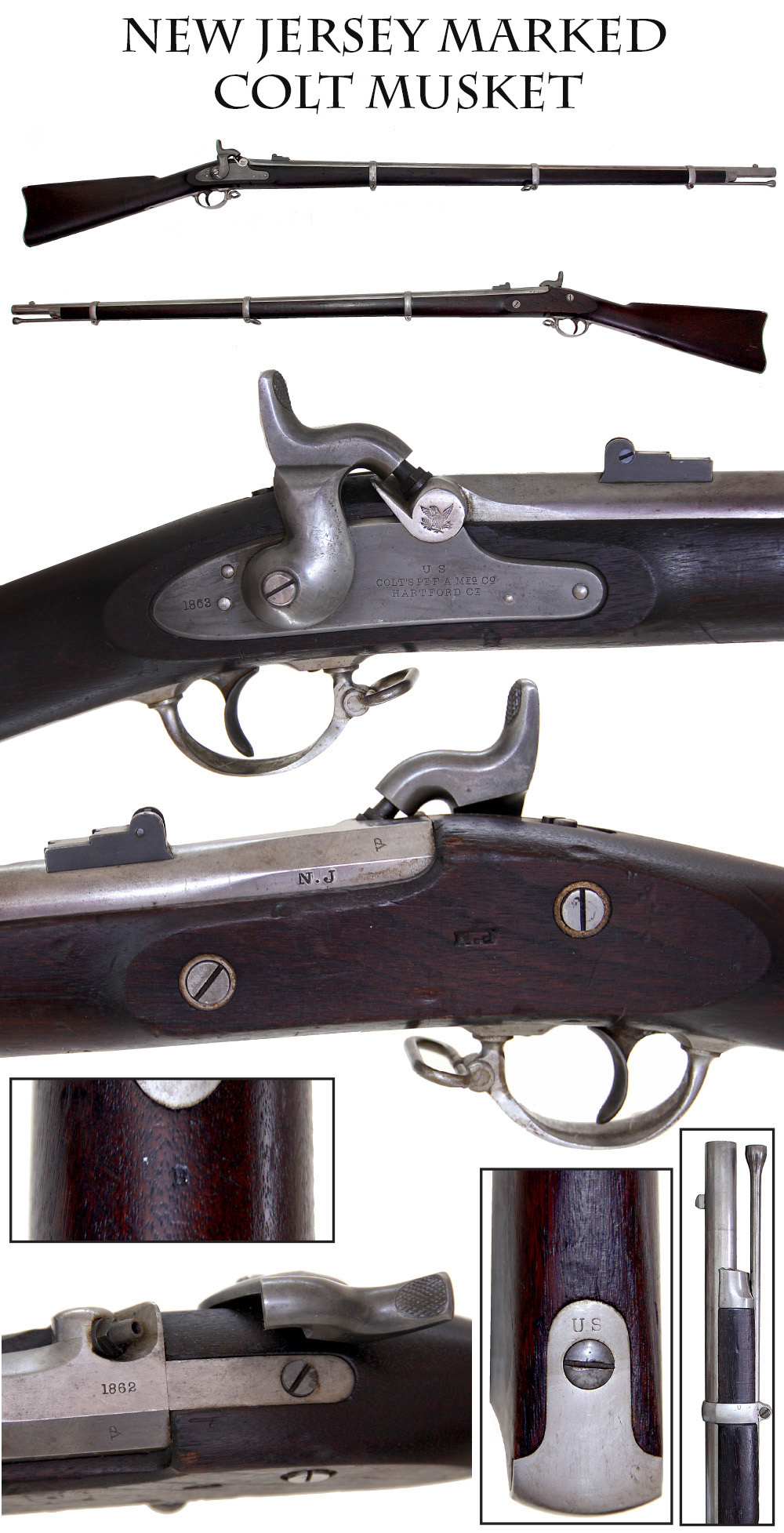
15-03-26 … A “SPANKY” New Jersey Marked Colt Rifle Musket:
Extra fine condition … excellent approaching mint. “Minty” in the current gun traders vernacular. 1862 dated barrel and 1863 dated lockplate indicating assembly at the beginning of 1863. I wish all my long guns were this sharp. Metal in the bright, blue still present on the rear sight, flowing muted case color on the lockplate and hammer, tight wood to metal joins, sharp edges, crisp NJ barrel marking on left flat and wood cartouche opposite lock, VP inspector mark upper left flat, crisp eagle on the bolster and “US / Colt’s Pt F A Mfg Co./ Hartford Ct.” forward of the hammer. All swivels, and bands, sights, rod, in place. Excellent mechanics and bore. A couple of light handling marks, that’s about it. They don’t come much nicer. One you won’t be ashamed of, and your friends will have a hard time keeping up with
… $3,250.00
Click Here to E-mail Us!
Call us @ 419-842-1863
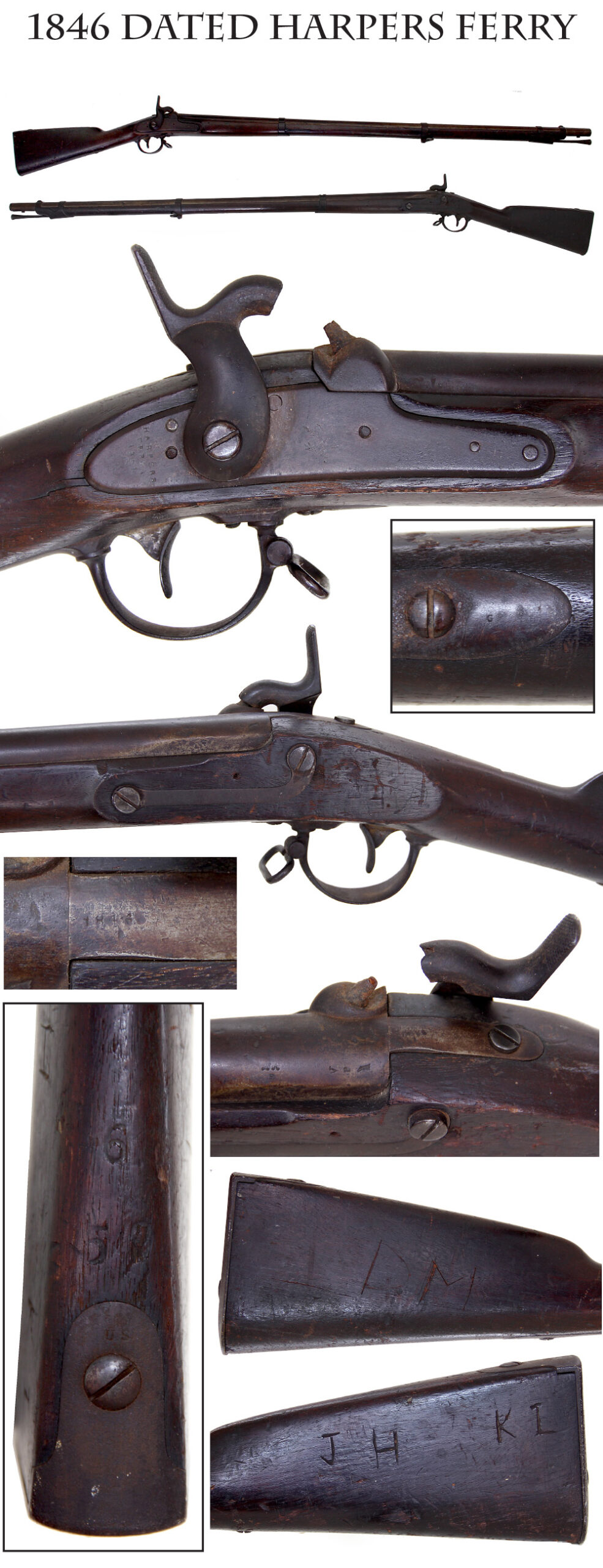
15-03-27 … Mexican War Dated Harpers Ferry ’42 Musket – A Real veteran …
1846 dated 1842 pattern .69 Caliber musket. The last of the regulation .69 caliber US infantry arms and the first of the issue percussion long arms. I’d call this attic condition, but there is no crustiness to the metal, just aged browning, mostly smooth, just some roughness around the nipple from firing. HARPERS/ FERRY/ 1846 a tad light but readable behind the hammer, the eagle worn but present forward. Two light cracks coming off the rear of lock platform, but very short and the wood is tight and has very good edges. Some abrasions and handling dings, particularly opposite the lock, but nothing horrible. Light but visible matching 1846 barrel date. Clear VP/ eagle and barrel inspector markings at breech. Handling dings on the offside, a regimental or company and rack number on top of buttstock, two sets of initials cut in one side and one set scratched in on the other. Bayonet stud, bands, springs and rod in place. A very real veteran from the southern arsenal that certainly saw use. These Harpers Ferry examples are much more desirable than their cousins made at Springfield up in Massachusetts. The fact that the HF guns were made in Virginia is a lot more interesting and gives those pieces a good southern flavor
… $950.00
Click Here to E-mail Us!
Call us @ 419-842-1863
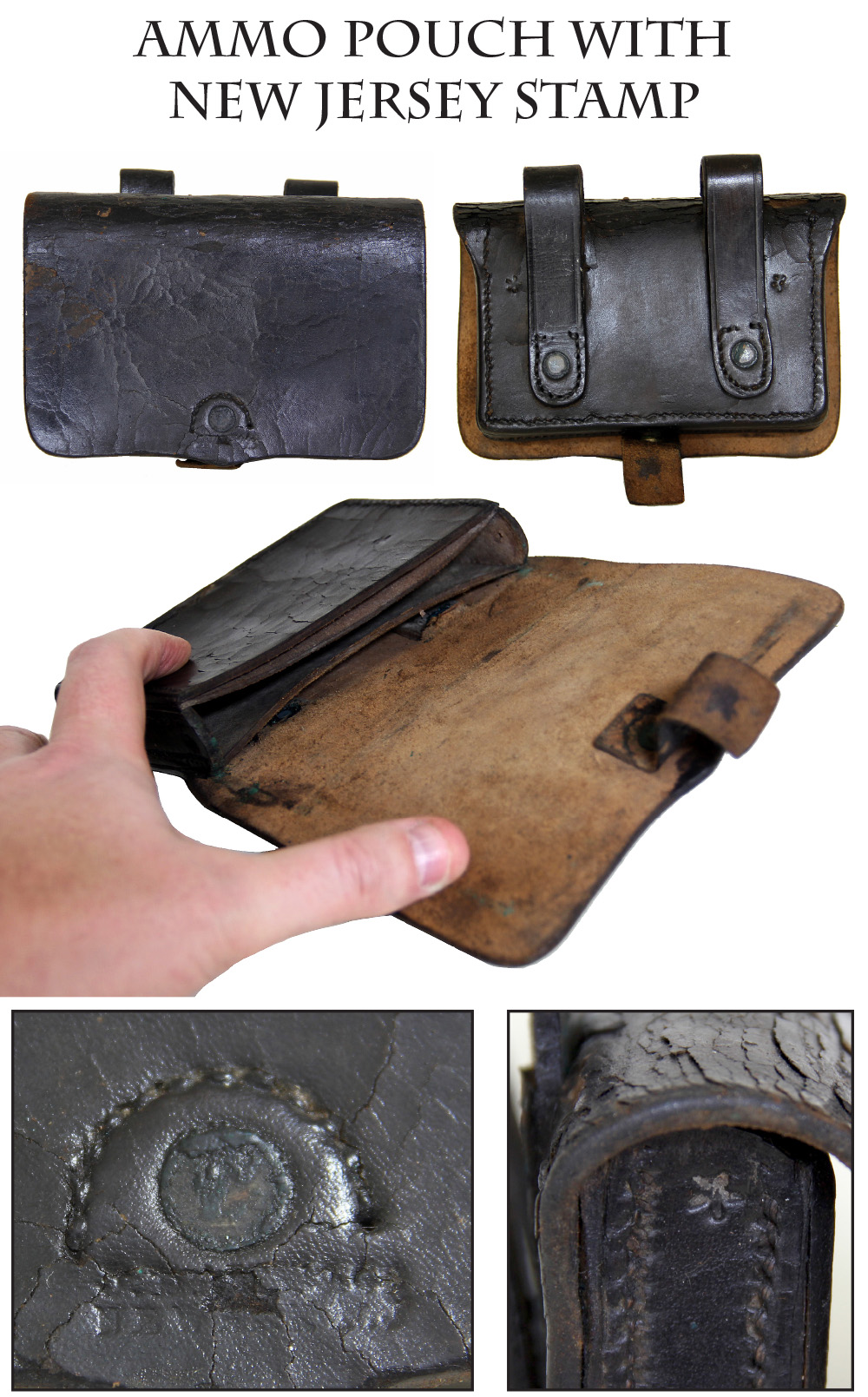
15-03-28 … J. Davy & Co. Newark New Jersey Marked Pistol Cartridge Box …
Davy was one of the big contractors for accouterments with the Federal government. Here is one of his pistol cartridge boxes. Good condition overall. Some crackling and crazing to the surface, but just minor losses to the finish and legible marks below the latch tab. Belt loops intact. Friction leathers in place inside that kept the cartridge packs in place. The usual asterisk stake marks used by the leather workers to close up the tack holes. A regulation issue item for cavalrymen that shows up in different configurations based on the design of the cartridge packs and used for both .36 and .44 caliber revolvers. Outstanding condition
… $225.00
Click Here to E-mail Us!
Call us @ 419-842-1863
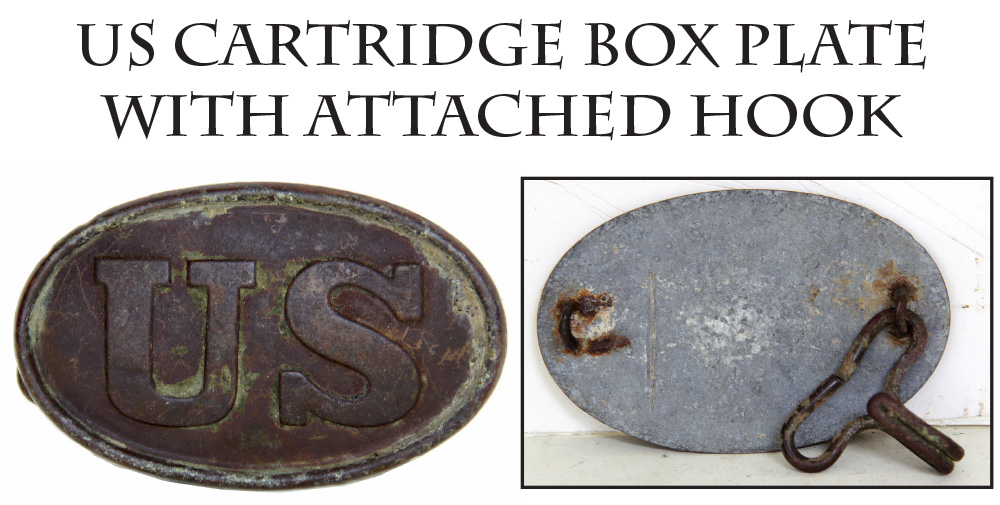
15-03-29 … Battlefield Found US Cartridge Box Plate With Knapsack Hook Attached By Soldier …
A neat excavated relic dug up in the 1970s. This one tells a little story. Soldiers do all sorts of things in the field. In this case for some reason a soldier attached a knapsack sling hook to a cartridge box plate. Your guess is as good as mine as to why. He simply opened the joint on the brass hook, looped it through and then closed it up again. One explanation might be that he had lost the thong to retain it on the box cover and the hook was simply at hand…. or it could have been a means of fabricating some sort of retaining hook for some leather harness. Or who knows, maybe it was just his lucky box plate and hooking it to his knapsack was a way to carry it after he was issued an 1864 pattern box. The ’64 boxes did not have plates issued with them. Whatever the reason it’s a cool mystery relic with a story behind it somewhere
… $250.00 – SOLD
Click Here to E-mail Us!
Call us @ 419-842-1863
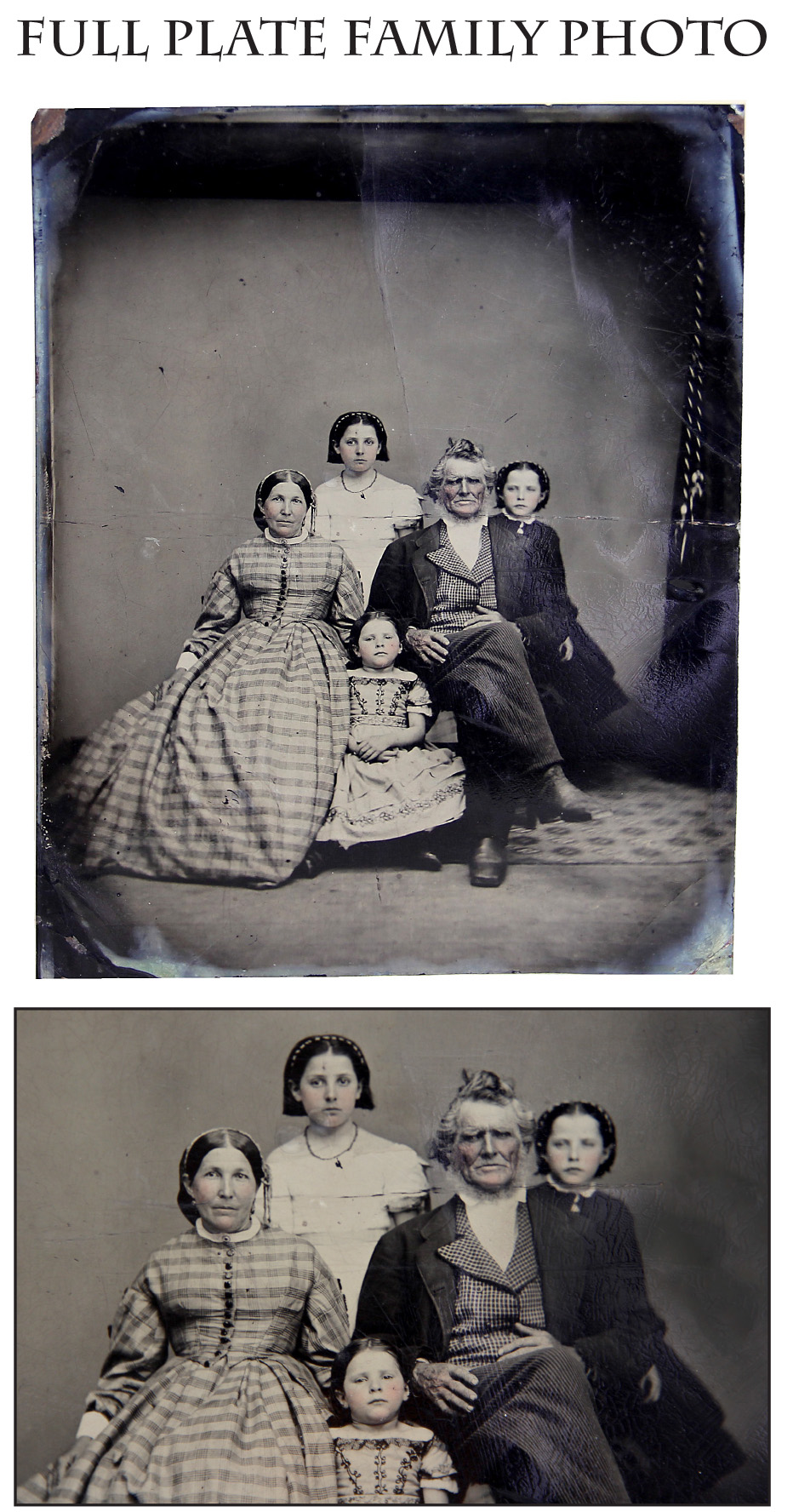
15-03-30 … Sharp Full Plate Family Tintype …
This photographer knew his craft! I don’t have to tell experienced collectors how hard it is to find a full plate tintype with any kind of resolution and clarity. Most of them are fuzzy around the edges of the figures at best and many border on the blurry. Here is one with the sharpness of a daguerreotype or ambrotype. A plain backdrop highlights the five figures and the lighting is excellent. The patriarch of the family is seated next to his wife and surrounded by three daughters. They have the required serious expressions for a family portrait, but have avoided the scowls that sometimes creep into the studio. Probably taken about 1860, the gent is a tad behind the time in his attire, but everyone has on their Sunday best. A slight horizontal crease has made a line in the emulsion, but there is no flaking and this would look superb in a period frame or full plate case. I believe this is the sharpest, clearest, best contrasted Full Plate (aka Whole Plate) tintype I have ever owned. I wish it bore military subjects
… $75.00 – SOLD
Click Here to E-mail Us!
Call us @ 419-842-1863
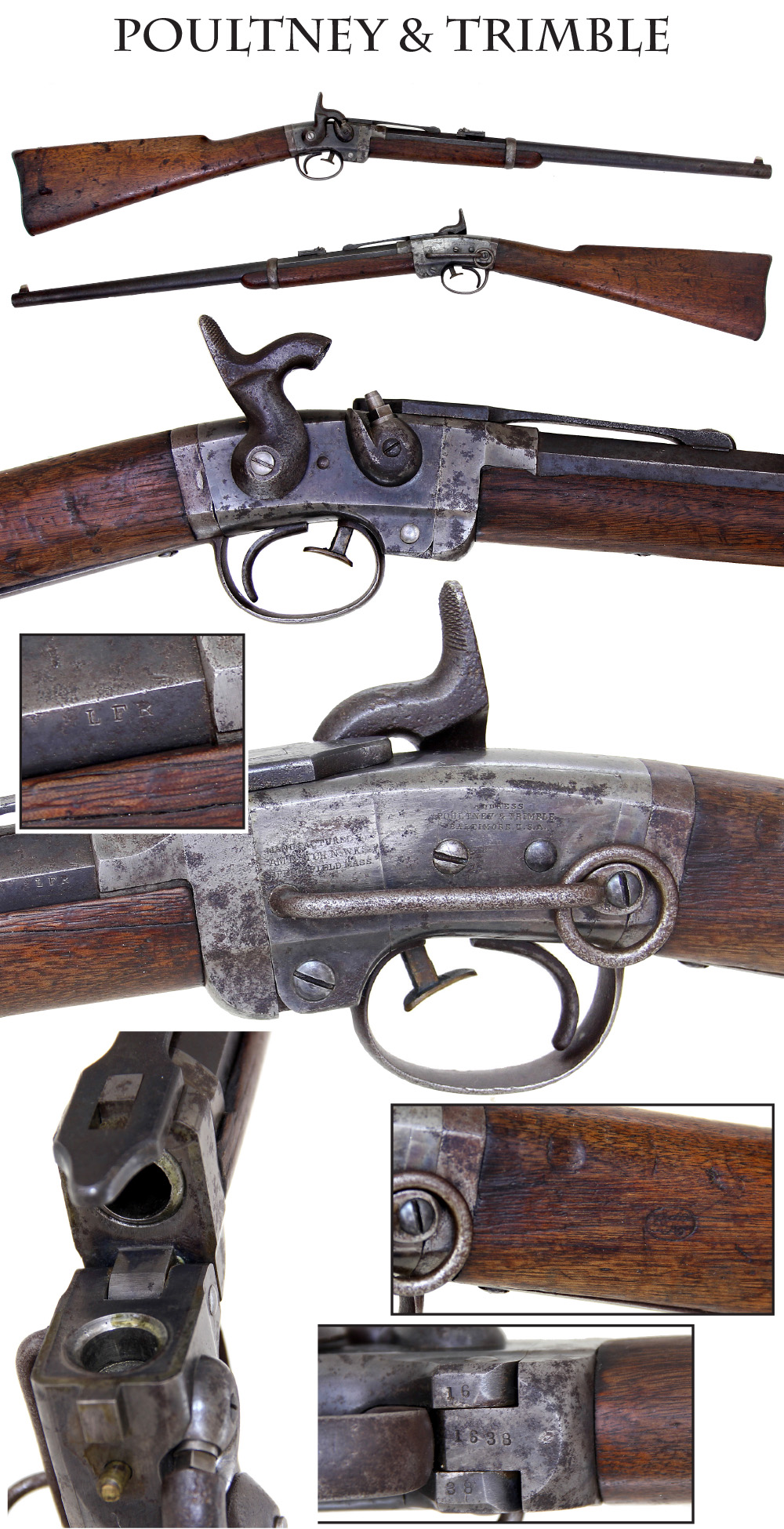
15-03-31 … Smith Cavalry Carbine …
A very popular Civil War carbine patented by Gilbert Smith, opening like a modern shotgun at the breech by depressing a latch ahead of the trigger. Made by three different manufacturers, almost the entire production run was purchased by the government. This one is made by the American Machine Works of Springfield, Mass, and has their company name in abbreviated form on the left side of the breech, along with the stamp of Poultney and Trimble, agents for Smith. Matching serial number 1638. Overall VG condition. Sights, barrel band, sling ring, etc., all in place. Hammer screw and nipple are replaced. Walnut stock medium light tone with darker dings here and there. Has a very visible cartouche at the wrist. Barrel preserves a lot of its blue. Top latch shows a lot of color as does the receiver on the right side. Hammer has color but is a bit rough, color is weaker on the left side of the receiver and the blocks fore and aft of the receiver, which are silver gray with brown spots. LFR barrel mark, fairly tight action. These .50 caliber carbines were issued in all theatres to many regiments: the 1st CT Cavalry, the 17th PA Cavalry, to name but two. A very affordable Smith that shows real wartime wear … hjj
… $1,195.00 – SOLD
Click Here to E-mail Us!
Call us @ 419-842-1863
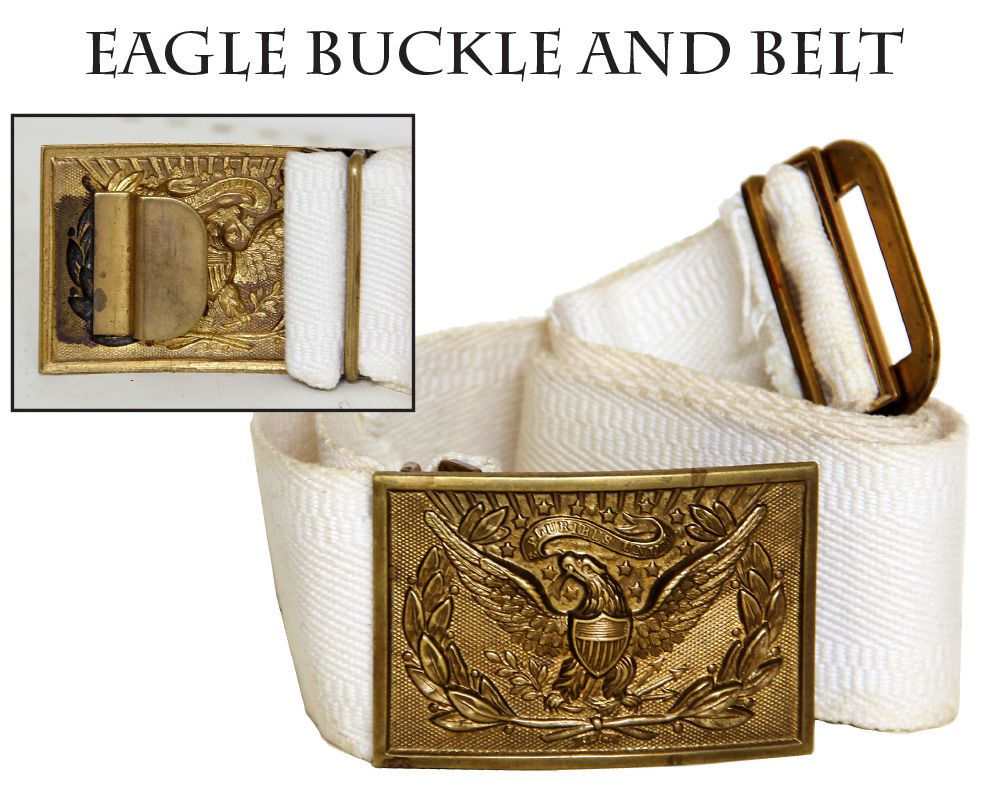
15-03-32 … Indian War Eagle Plate And White Web Belt …
This is the Indian War pattern of the rectangular eagle belt plate, made with a loop attached to the rear of the plate for the belt rather than a side slot. This one was made with and open back for a lighter weight and has a broad fastening hook. With it is its matching keeper, and they are both mounted on a light weight white web belt. Possibly intended for a military bandsman, whose uniforms were very showy, this preserves most of its color and is pretty impressive even now
… $85.00 – SOLD
Click Here to E-mail Us!
Call us @ 419-842-1863

15-03-33 … 1872 Pattern Cavalry Officer’s Saber …
A nice example of the regulation cavalry officer’s saber of the Indian War and Spanish-American War period up to 1902. Bright steel scabbard with brass mounts, just a little age graying. Black leather grip with narrow twisted wire. Very elaborately cast guard with crouching eagle and stars on a sunburst, cast decoration even on the branches and a US shield with floral motifs on the pommel. Black leather grip with a thin wire wrap. Blade is silver gray with darker gray areas that displays well the eagle and ribband surrounded by stars and floral motifs on one side and a nice “US” surrounded by rays and floral and geometric motifs on the other. Brass mounted steel scabbard is solid and lacks the throat. “Ridabock & Co. / New York” stamped lengthwise on the ricasso. Ridabock was successor to Baker and McKenney starting in 1883 and began advertising under his own name in 1888. A good example of a key regulation US officer’s saber in an American sword collection. One of the few remaining affordable 19th century edged weapons
… $250.00 – SOLD
Click Here to E-mail Us!
Call us @ 419-842-1863
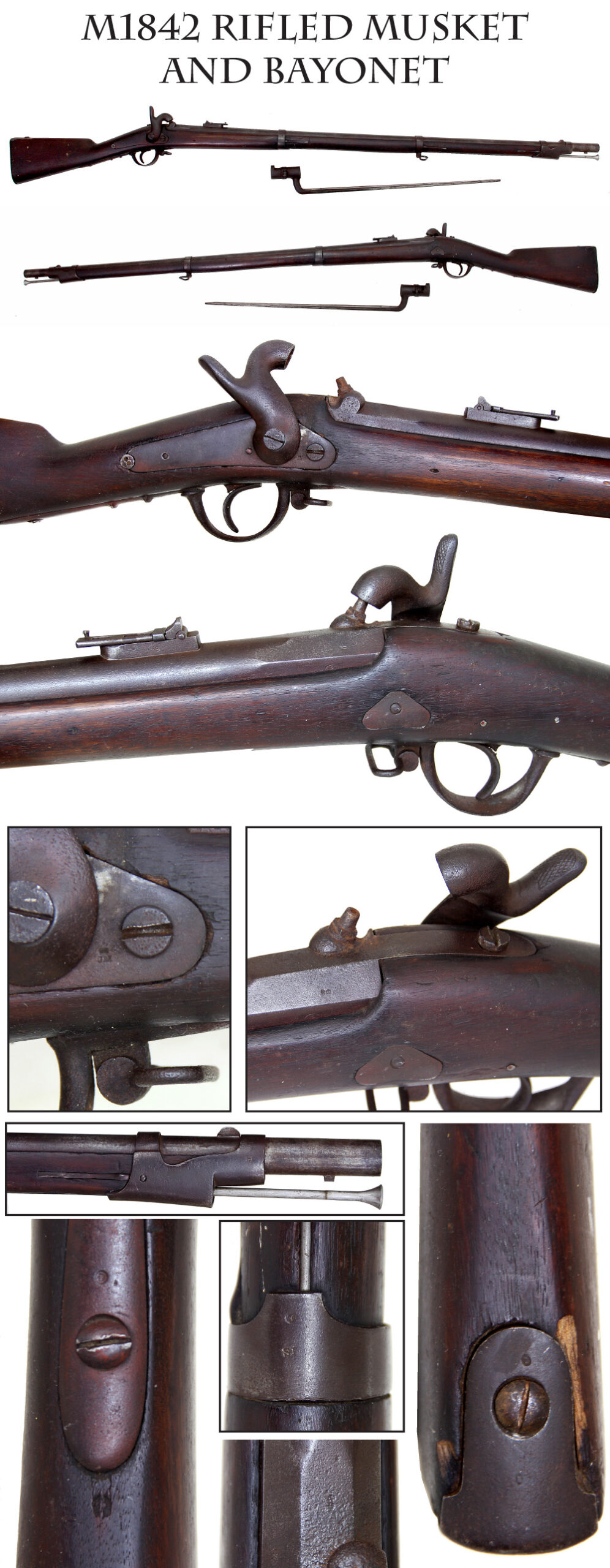
15-03-34 … Civil War Import .69 Caliber Rifled Musket and Bayonet …
Patterned on the French 1842 infantry musket, but lacking French arsenal marks and having a bolster somewhat like the French 1857 dragoon rifle, this is likely a Belgian made commercial version of the French rifled musket, typical of the weapons gathered in from European arsenals and arms dealers by American agents of both sides in the early years of the war. Nice wood overall. The metal is brown with some light peppering. Long range rear sight, front sight, bayonet stud, all bands and swivels in place. The rod is a modern reproduction that will do until a period one comes available. With the gun is its correct bayonet. Maker and inspector numbers and initials present. Some light abrasion near the buttplate tang. Some light corrosion near the nipple from firing. A good early war long arm proper to display with US or CS effects. With the bayonet (worth 125 by itself) …. sw-dej … ba-ajj
… $795.00
Click Here to E-mail Us!
Call us @ 419-842-1863
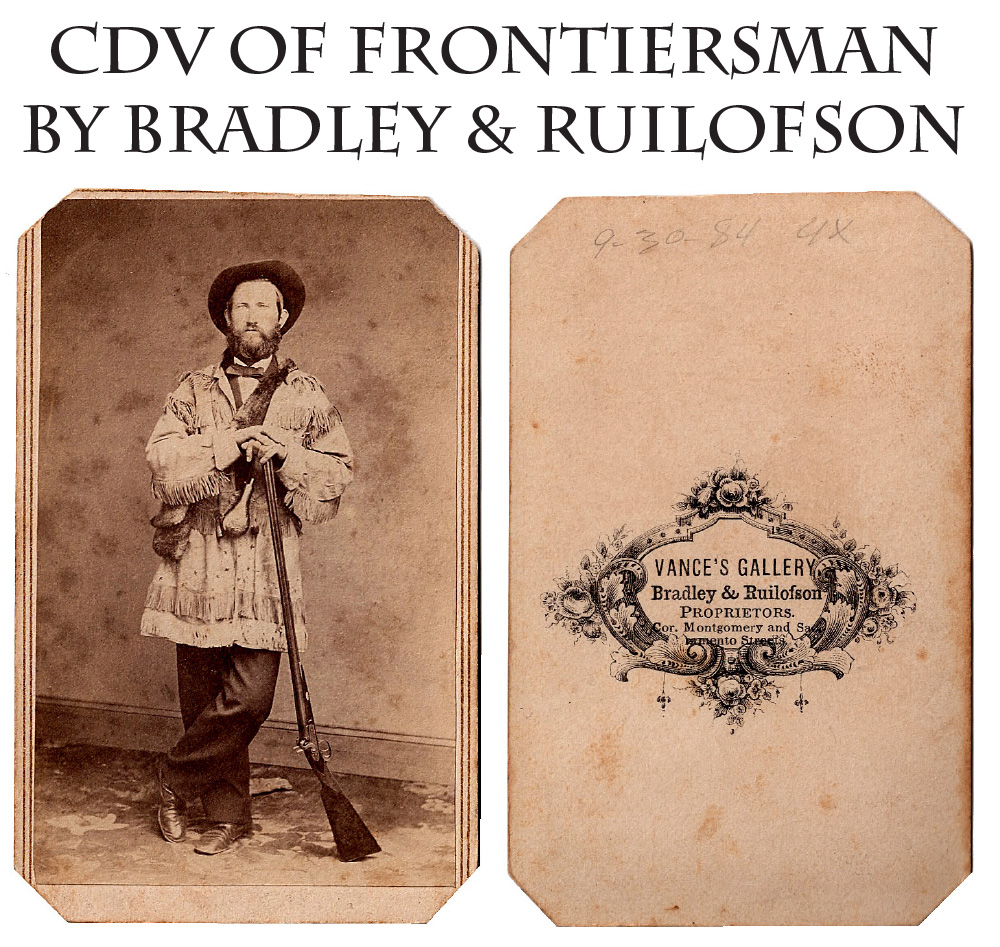
15-03-35 … 1861 era CDV Of A California Hunter By Bradley And Rulofson Of SanFrancisco …
Bradley was a North Carolinian who came to California in 1850 during the Gold Rush and set up a studio in San Francisco. He was joined by Canadian William Rulofson in 1861. They became very well known for the quality of their images and for the lavishness of their studio: elegant rugs and fixtures, even an elevator for clients. Here they have photographed a well-appointed frontiersman or hunter, posed leaning on his shotgun wearing an elaborate fringed hunting shirt over his city duds, with his powder flask and shot bag and hunting pouch hanging over his shoulder, his brimmed hat pushed back on his head gives a good view of his frontier hardened face. Corners of the card trimmed for album insertion, minor foxing that blends in with sepia tone of the albumen. The backmark labels the studio as “Vance’s Gallery” and misspells Rulofson’s name as Ruilofson, indicating this is probably an early product of the famous partnership. A nice western shot of a bearded Californian who is certainly old enough to be one of the original 49ers … abjww
… $350.00 – SOLD
Click Here to E-mail Us!
Call us @ 419-842-1863
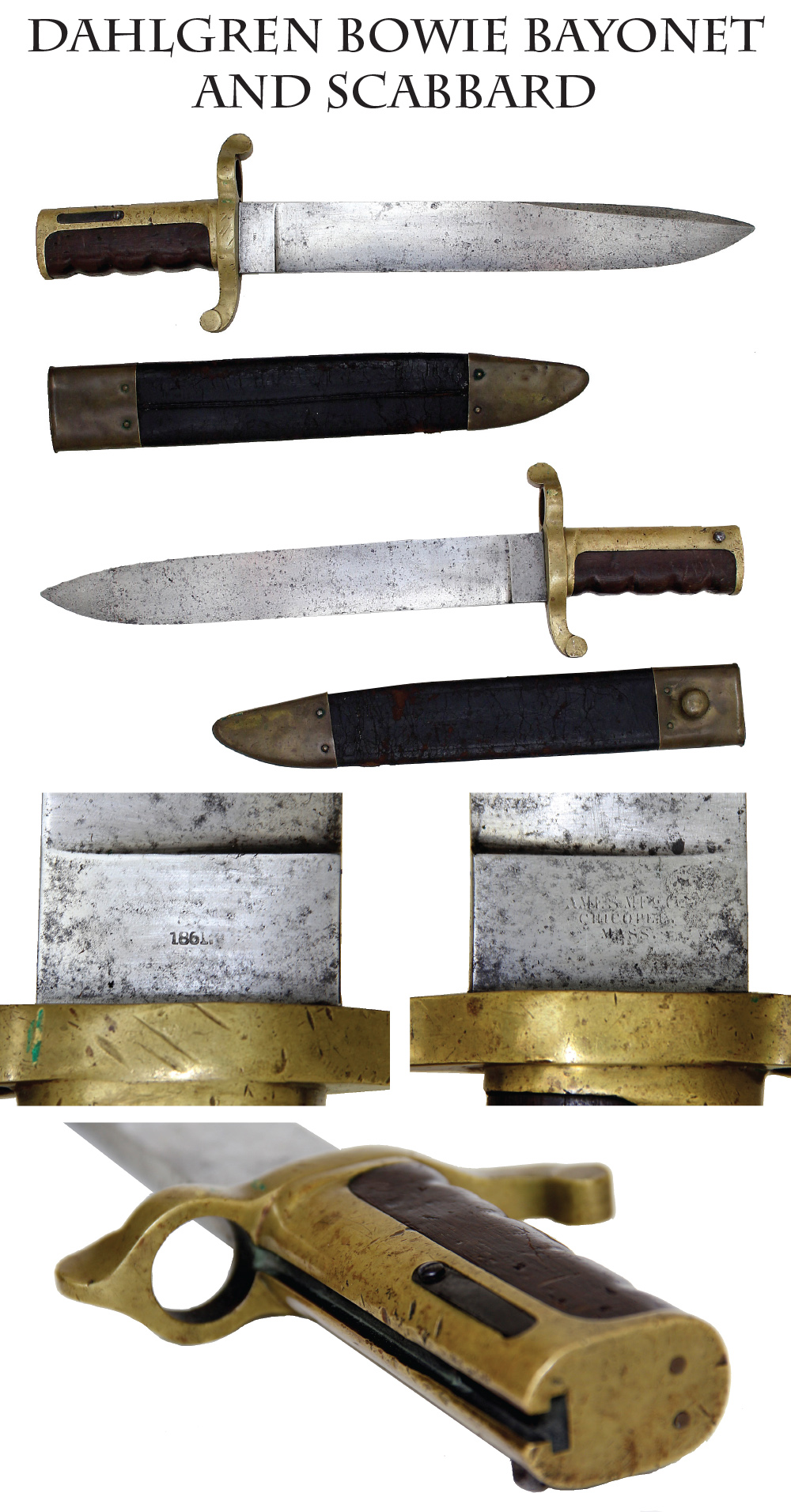
15-03-36 … Dahlgren Bowie Bayonet
… One of the most highly sought of all Civil War knives / bayonets. This deadly edged weapon fit the iconic Whitney-Plymouth Navy Rifle. Overall VG to near fine condition. Complete with original brass mounted scabbard. Nicely marked with 1861 date and full Ames firm markings … blade is 12″ in length … handle is 4 1/2″ for 16 1/2″ total length
… $1,650.00
– SOLD
Click Here to E-mail Us!
Call us @ 419-842-1863
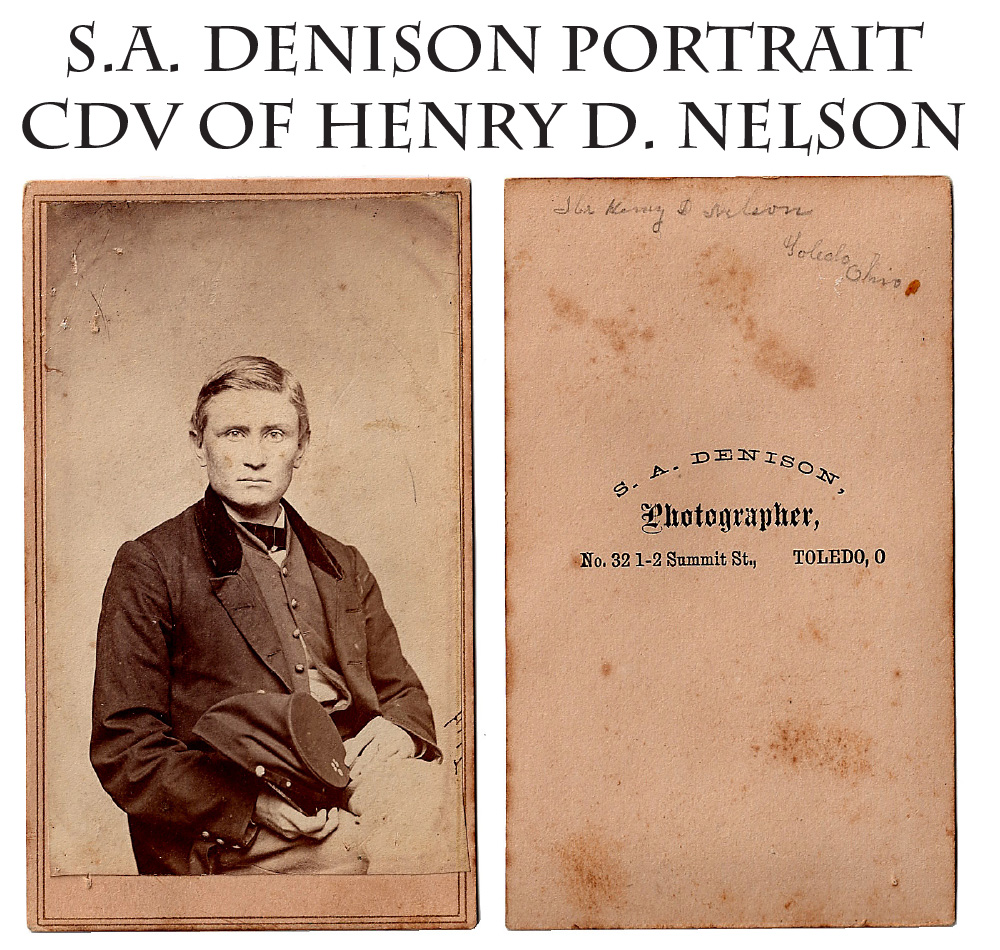
15-03-37 … CDV Of A Toledo, OH, Soldier 25th Ohio Regiment 95th? …
Two-thirds seated view of a soldier posed with his forage cap in hand showing the viewer a two-digit regimental number over a company letter. His coat at first seems a civilian garment, but the three eagle cuff buttons indicate he is wearing a high-grade commercial sack coat. Period pencil identification on reverse: “Mr. Henry D. Nelson / Toledo / Ohio” and there is a Denison, Toledo, photographer backmark. Several Henry Nelsons show up in the Ohio records, but none in the 25th Ohio, which seems to be the number on his cap. One of them is in the 95th OVI, which fits the second digit, but I can’t quite convince myself the first number is not a “2.” That soldier enlisted at age 36 in August, 1862, and served until October, 1863, when he died of disease at the regimental hospital in Oak Ridge, Tennessee. He served, however, in Company F, and the man’s company letter appears more a C or G. It is possible the name on the reverse is the intended recipient of the card. In any case, this is a nice view of a Toledo soldier displaying a great forage cap … zzbj
… $75.00
Click Here to E-mail Us!
Call us @ 419-842-1863
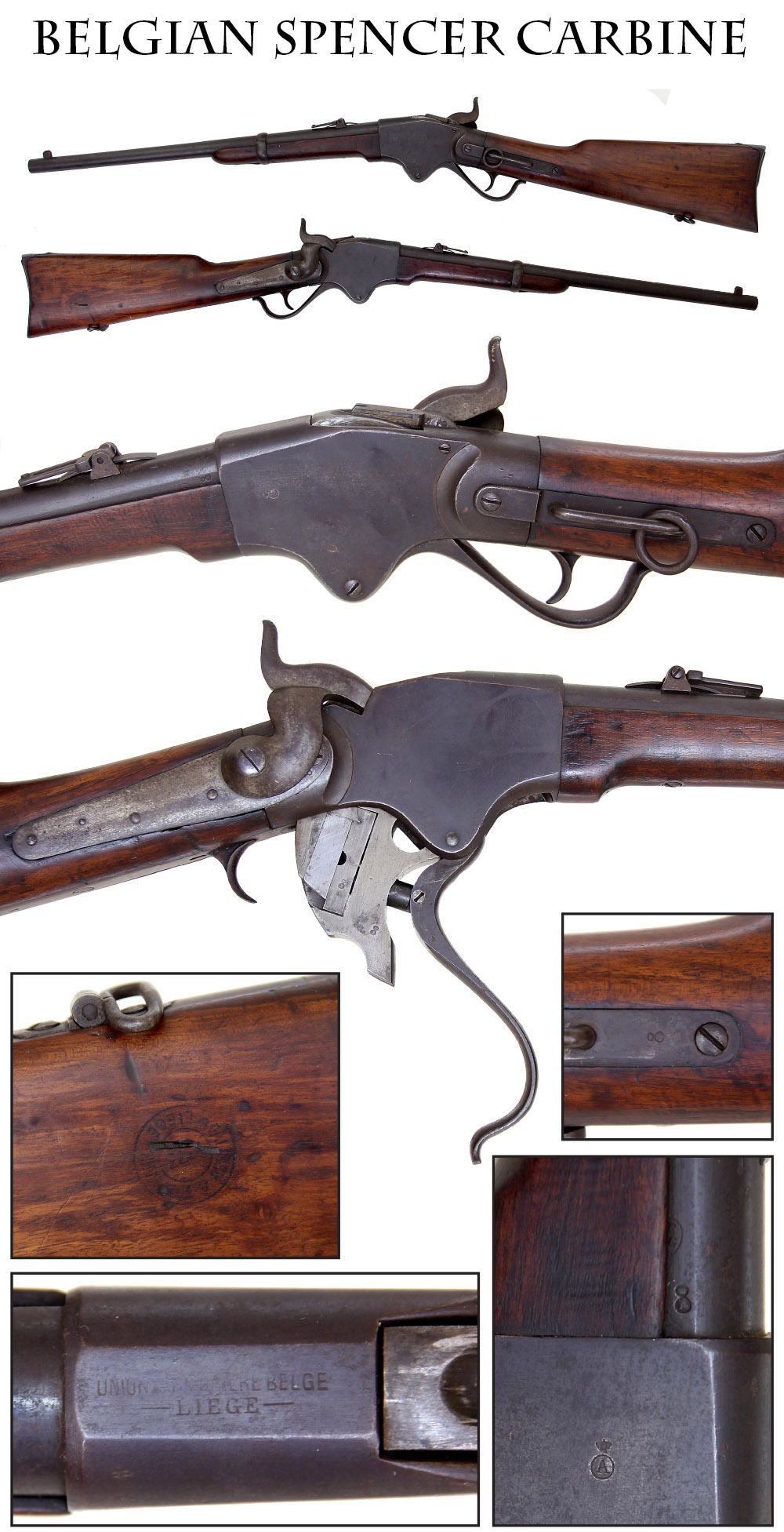
15-03-38 … Belgian Center-Fire Spencer Carbine / Less than 1000 Manufactured:
Surplus American Spencers were popular arms in the hands of French troops during the Franco-Prussian War of 1870-1871. They were so popular that after the war the Belgian firm of Falisse and Trappman of Liege began manufacturing Spencer carbines in 1873 since the Spencer company stopped making them in 1868. Estimates are that fewer than a thousand were manufactured, making this a darn scarce variant for the Spencer collector. The carbine is .50 caliber with a 20-inch barrel. Front and back sights are in place, magazine tube, swivel, band, and sling bar and ring also present. Overall VG+++ condition. Metal is smooth. Muted blue turning plum brown on the barrel and receiver. Lock plate silver gray and brown. Wood is very good, just minor handling dings. Round Liege stamp in the buttstock flat, serial or assembly numbers as well. A crown over an “A” in a circle is the mark of J. Ancion and son of Liege. They were active under the name “Fabrique d’Armes de Liege.” The top of the receiver is marked ” Union … Belge / Liege” which is probably their business name for the marketing of the Spencers. The word following “Union” is light, but “Union” is undoubtedly intended to evoke American associations with the famed repeating rifle. Far rarer than an American Spencer and more affordable!
… $1,850.00 – SOLD
Click Here to E-mail Us!
Call us @ 419-842-1863
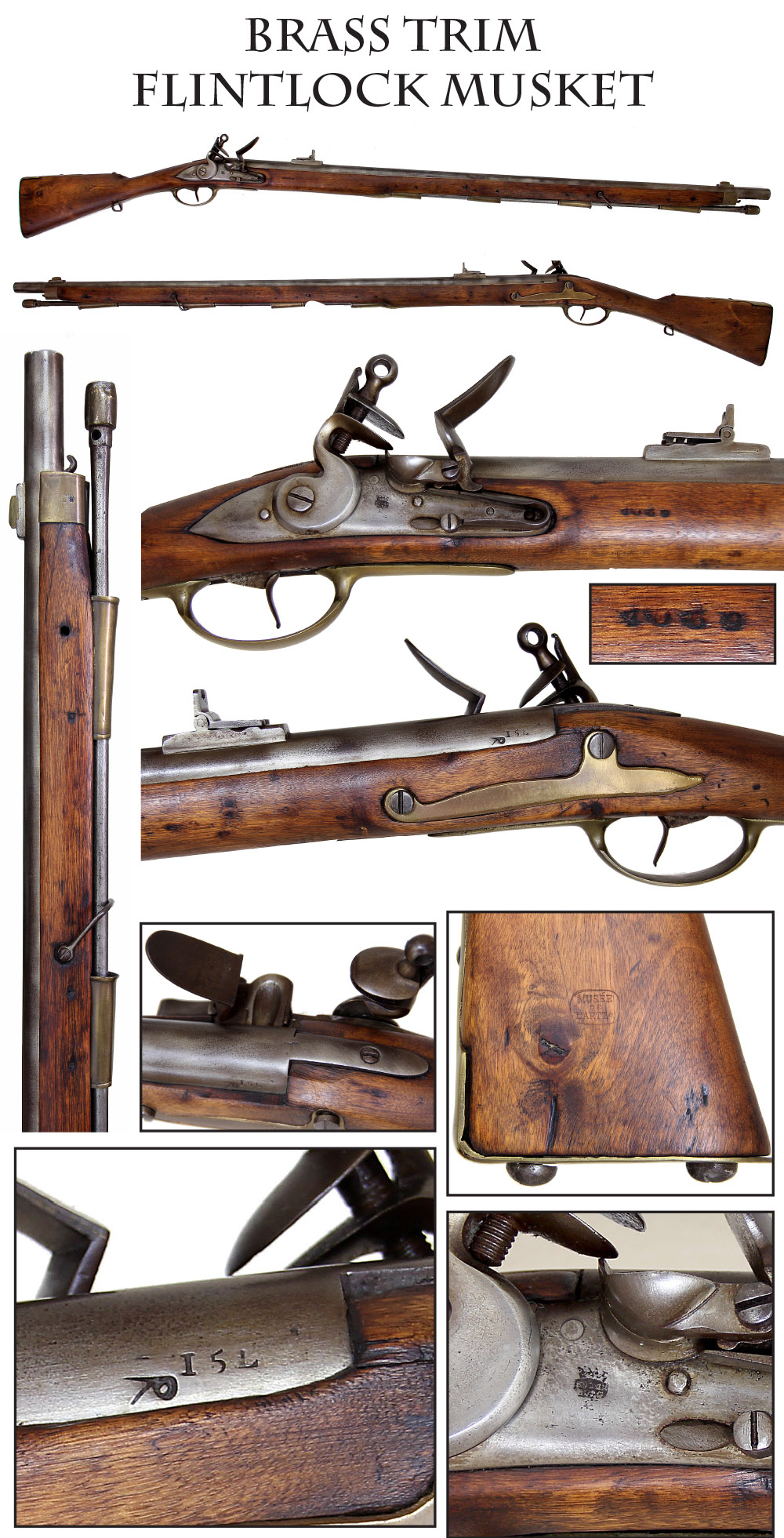
15-03-39 … Brass-trimmed European Flintlock Rifle Musket …
This heavy-weight is one mean old musket. Germanic looking butt plate with large screws sticking out to make firing memorable for the soldier, long front blade sight on a rectangular base. Spring catch under the muzzle for a socket bayonet with no slot. Heavy ramrod with torsion peg hole and four large brass ramrod pipes. Brass side plate, butt plate, and nose cap. A couple of numbers at the barrel breech and a cartouche forward of he hammer that I can’t quite make out and possibly a number stamped in the wood forward of that. Overall VG condition with evidence of burnishing in the not too distant past. A stamp in an oval cartouche on the butt reads: “MUSEE DE L’ARTLe” so I expect this came out of a French institution at some point, possibly brought home by a soldier after WW2 ??? One local “expert” said this pattern existed back into Colonial American times. I am guessing this one dates to the 1820s or 1830s. Interesting and affordable
… $695.00 – SOLD
Click Here to E-mail Us!
Call us @ 419-842-1863
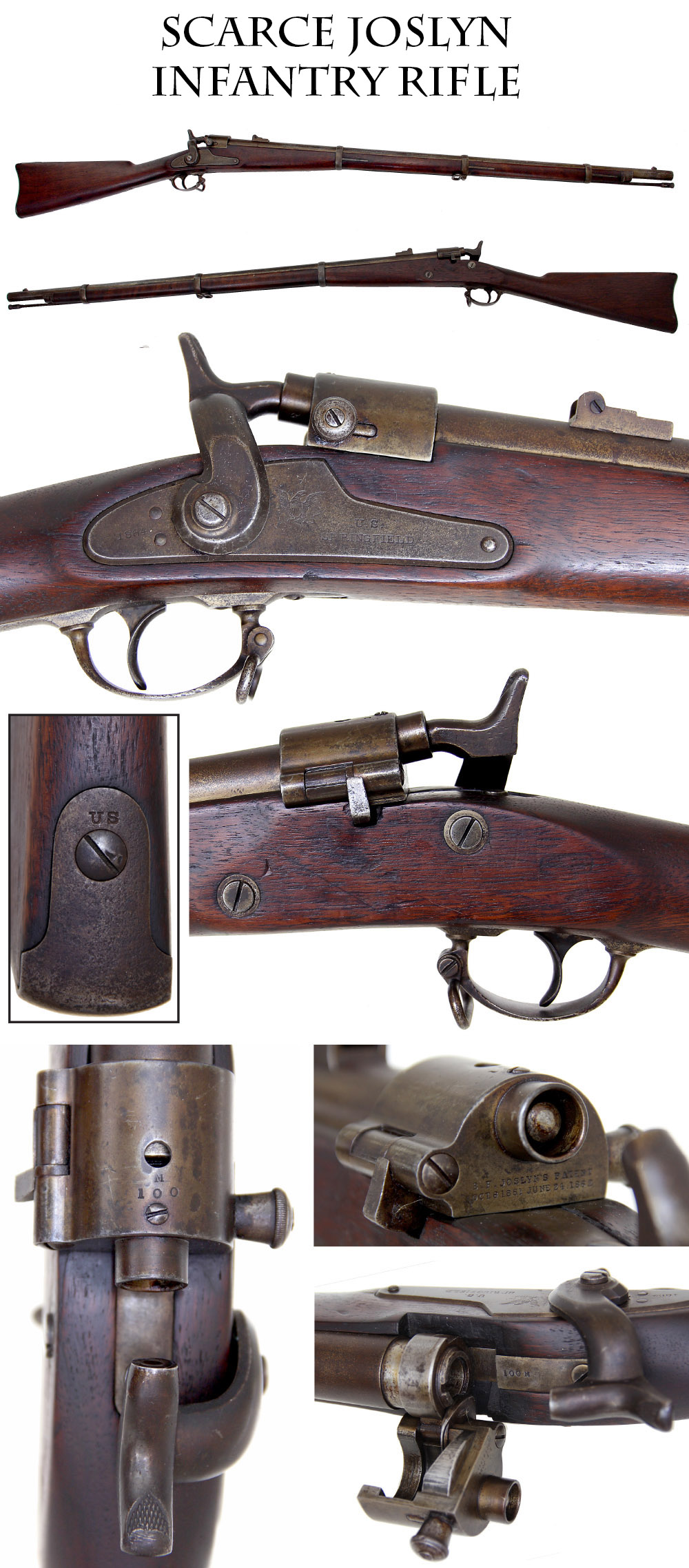
15-03-40 … Joslyn Breech-Loading Rifle …
Once thought to be post-war alterations we now know that they are actual wartime rifles. Over 3,000 of these rifles were made at the Springfield Arsenal between January and June of 1865, firing the Joslyn .50 rimfire cartridge made at the Frankford Arsenal. It is thought that they were issued to troops before the war ended. They show up in a few photographs of postwar western troops, and are the first true breech-loading cartridge arm made in any quantity at a national armory. This one is a near fine example, Nice wood, smooth metal with a warm nicotine patina. Very sharp Springfield 1864 lockplate markings and crisp Joslyn’s patent marks on the face of the swivel breechblock. Matching number 100/M on the top of the breech and the tang. Crisp action, all swivels, bands, sights in place, as is the cleaning rod. These are not converted rifle muskets, but newly made at the arsenal for the breech mechanisms that were supplied by Joslyn and as such have not only different stocks, but also specially made barrels. A scarce Civil War military arm and a key piece in the history of US arms. A top drawer specimen
… $1,850.00 – SOLD
Click Here to E-mail Us!
Call us @ 419-842-1863
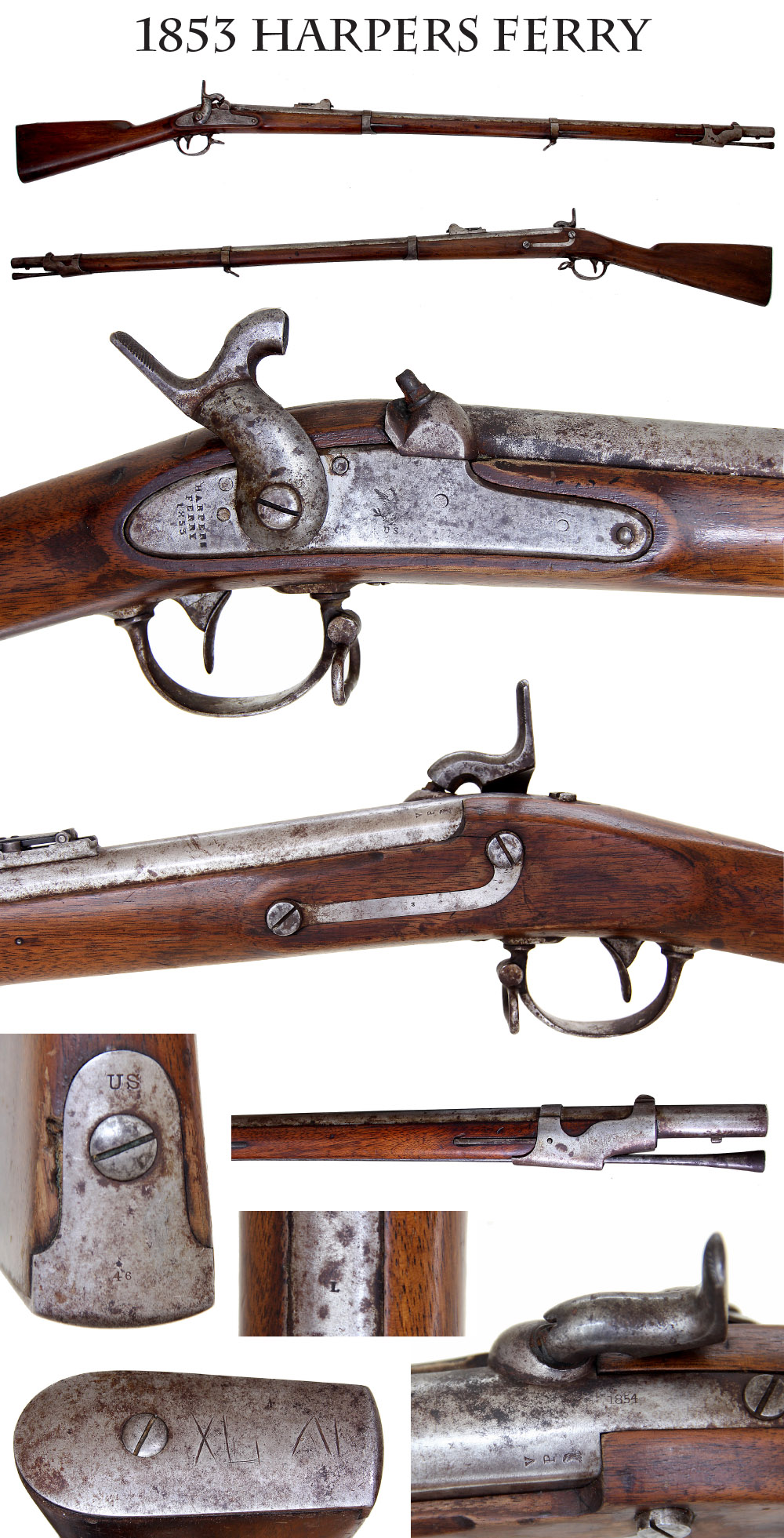
15-03-41 … 1853/54 Dated Sighted Harpers Ferry Model 1842 …
When the 1855 series of rifled and sighted arms was introduced there was a rush to retrofit existing arms and bring them up to current standards. Here is an 1842 musket made at the quintessential southern armory, Harpers Ferry, brought up to snuff by rifling the bore and adding a long-range rear sight. This gun was later bored out and no longer retains rifling. Very clear VP/eagle proofs on the barrel, lockplate date of 1853 and barrel date of 1854 on the tang, which is totally correct for rifled 42s. When the muskets were disassembled for retrofitting no attempt was made to retain matching locks and barrels. The parts are totally interchangeable and the arsenals mixed and matched them. I once owned a rifled and sighted Harpers Ferry with a Wm. Glaze SC barrel on it. Wood is good, cleaned many years ago producing a lighter tone, but not overly rounding its edges. Metal is silver/gray with some scattered purplish brown areas. Sights, bands, swivels and rod in place. Markings on the rear of the lockplate are sharp, the eagle and US forward of the hammer is rubbed on the right. Good nipple, not battered down. Some Roman numerals scratched on the buttplate. A good ’42 with nice southern associations
… $1,195.00 – SOLD
Click Here to E-mail Us!
Call us @ 419-842-1863
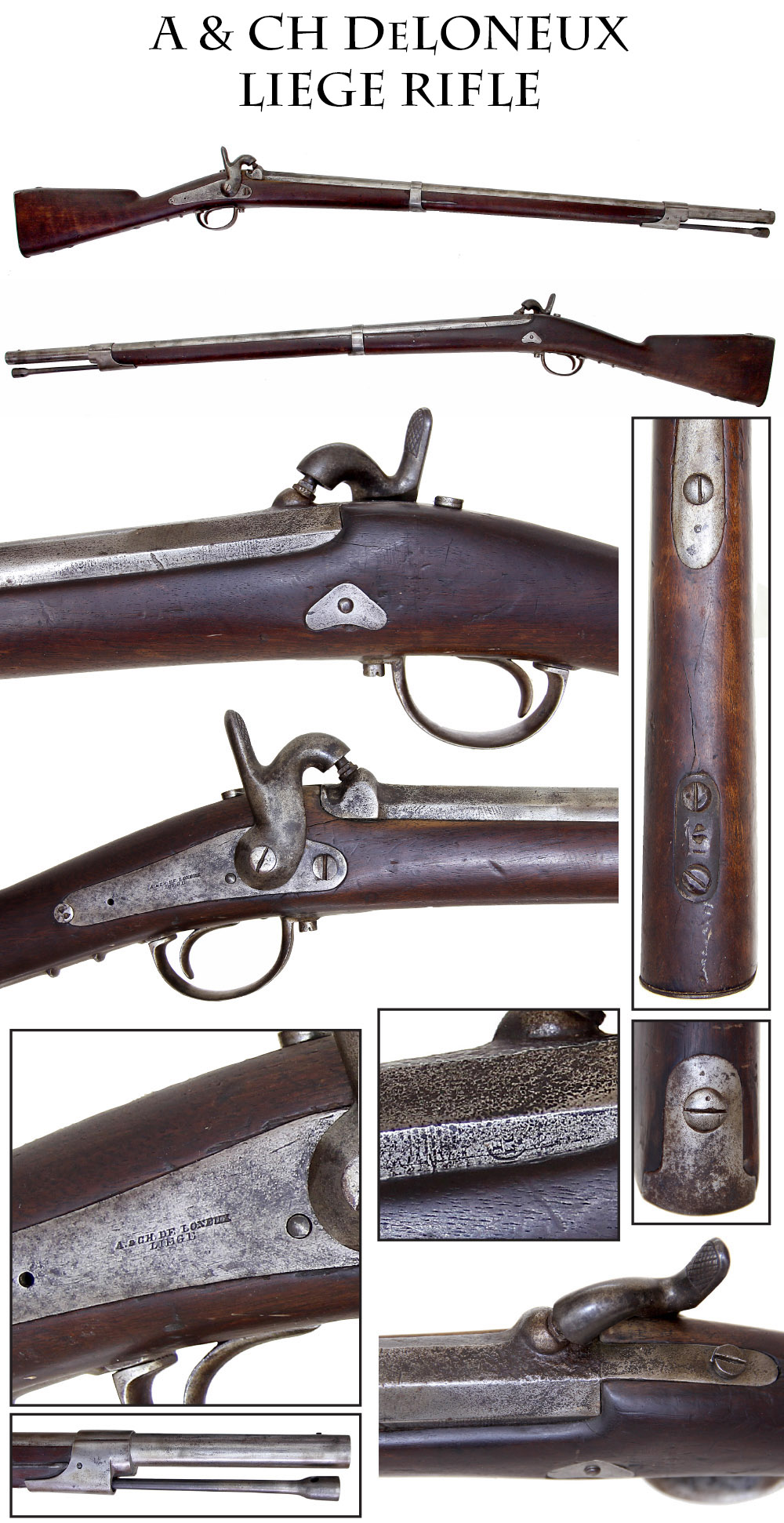
15-03-42 … Belgian Short Rifle Or Carbine …
Similar to the French 1846 short rifle or carbine, this two band rifle shows the Belgian maker’s mark on the rear of the back action lock: A & CH DE LONEUX / LIEGE and Liege proof mark on the left barrel flat. Some pitting at the breech from firing, but not obtrusive. Metal is bright silver gray overall. Missing the swivel at the base of the butt and likely one at the lower band. I see no bayonet stud, but the barrel extension indicates it probably took a saber bayonet. Good to VG condition. Lock does not function. The hammer is in the down position and will not move. I bought it cheap and will sell it cheap, so you can have fun fixing it … ppbbj
… $595.00
Click Here to E-mail Us!
Call us @ 419-842-1863
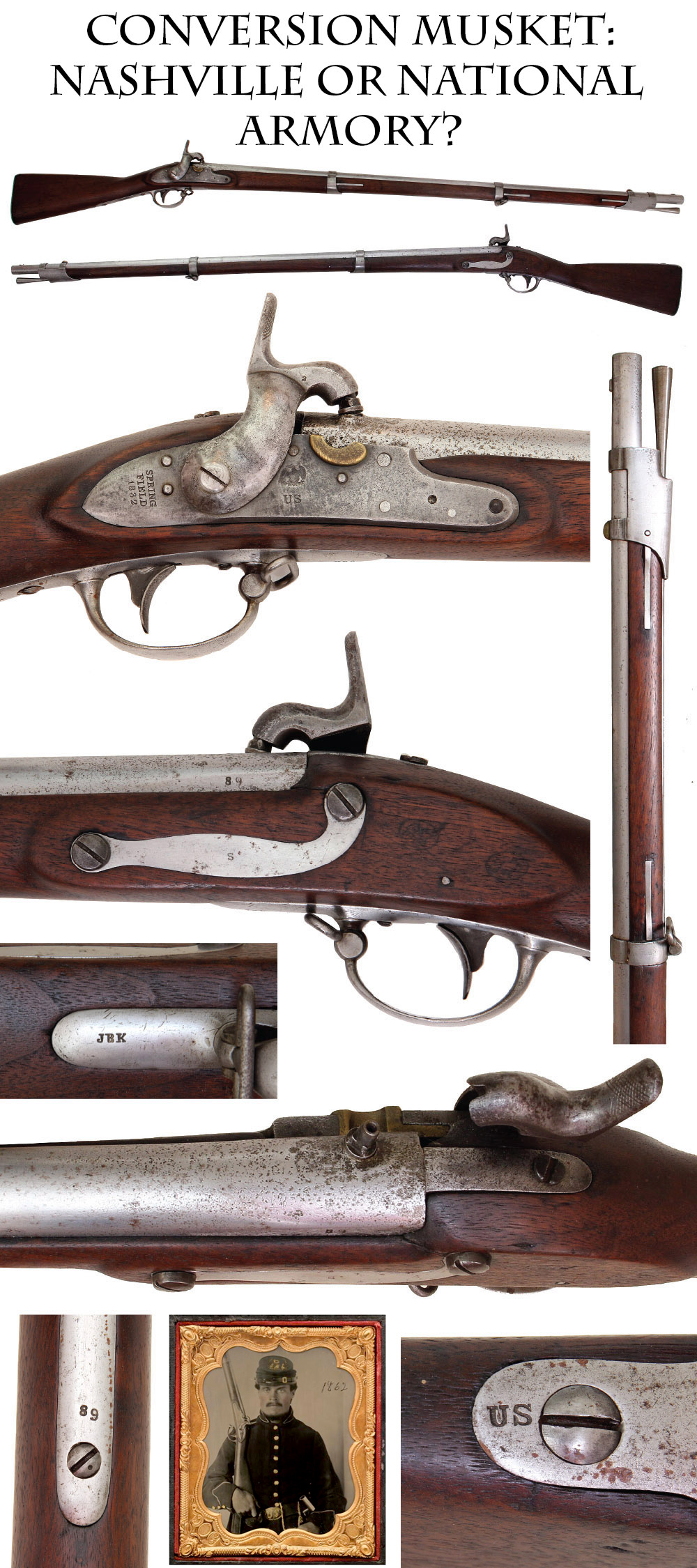
15-03-43 … 1832 Dated Model 1816 Springfield Percussion Conversion …
Early form “cone-in-barrel” conversion to percussion of an 1832 dated 1816 Type III pattern musket made at Springfield. Sharp lock markings and very clear ink wood cartouches opposite the lock. Small sub-inspector marks and re-assembly codes from its arsenal conversion clearly legible. Some light pitting near the nipple from firing, otherwise smooth metal in age-muted “national armory bright.” All swivels, bands, springs in place as is the correct ramrod. Nice color to the wood with a good fit to the metal, just minor handling marks and one small crack between the upper lock screw and the breech of the barrel on the left side.
In the late 1840s the government surveyed and classified flintlock arms in its armories for suitability for conversion. The best and most recent were converted to percussion by removing the external lock parts, shaving off the brass pan flush with the plate, changing the hammer, sealing the touch hole and then cold forging and tapping the upper breech for a percussion nipple. The lack of the small brass semi-circular insert soldered into the remains of the brass flash pan may indicate this was one of the guns converted at the Nashville, Tenn., state armory in 1860. They purchased one of the “Percussioning Machines” at the Pittsburg Arsenal along with 3,000 hammers and nipples to convert their own muskets, many of which would have ended up in Confederate hands. In any case, the lack of the insert is one of the diagnostics in identifying their conversions, which otherwise are like the Federal arsenal conversions according to Moller. Some were rifled to try to bring them up the 1855 standards, but the pressure created by the minie cartridge was too great and thousands remained in arsenals in this configuration to be issued out to the volunteers in 1861 who thronged the state recruiting depots on both sides. Roughly 1,500 altered 1816s remained in the hands of just the New York troops in the field at the end of 1862. A nice looking musket that shows an important stage in US arms development and key weapon in the early years of the Civil War
… $1,150.00
– SOLD
Click Here to E-mail Us!
Call us @ 419-842-1863
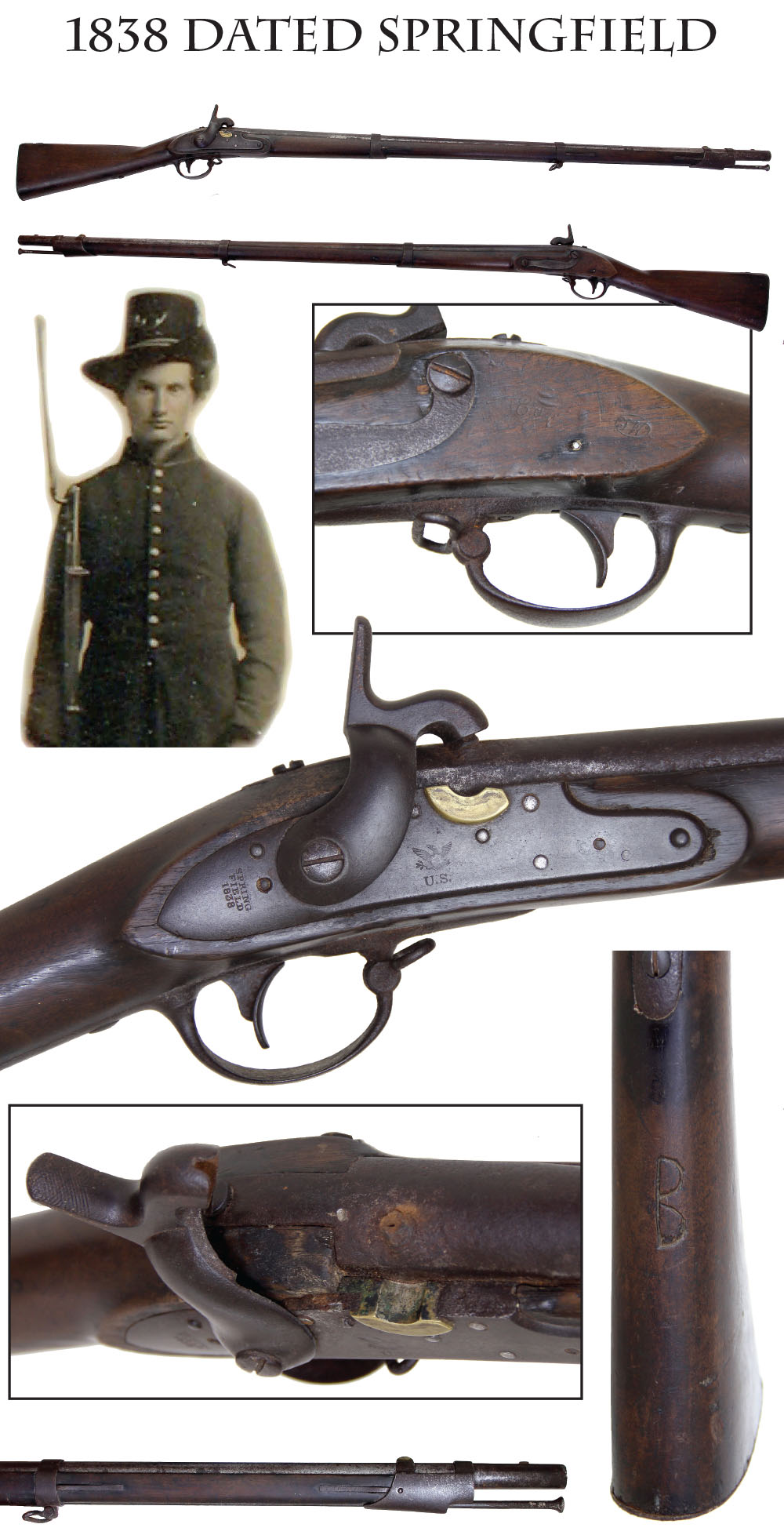
15-03-44 … Springfield M1816 Conversion Musket:
Typical Early Civil War musket used by both North & South with soldier’s initial carved in the stock “B” or “D over D”, behind trigger guard tang. This is an 1816 pattern musket smooth-bore .69 caliber, with a correct arsenal conversion to percussion using the “cone-in-barrel” or “Belgian” method of conversion. This was done from 1848-57. Of some interest is the fact that guns dated after 1832 were considered first class and prime candidates to be updated. Nice overall untouched condition. Smooth metal with undisturbed age brown patina, nice wood with just a few dings. The original 1838 date of manufacture is clearly stamped at the rear of the lock plate, as is “Spring Field”” and their eagle at front. Barrel markings are obliterated under deep rust brown patina. The inspector’s view mark (cartouche) on the wood opposite the lock is plainly visible. Swivels in place, correct original rod, front sight on top band, bayonet stud in place near muzzle. Mechanically excellent, 100% original 100% complete. These are the guns that fought the Civil War for the first couple of years until imports, arsenals and contractors could get up to speed. This is about as honest an 1816 as you could hope to find and priced very realistically at
… $850.00
– SOLD
Click Here to E-mail Us!
Call us @ 419-842-1863
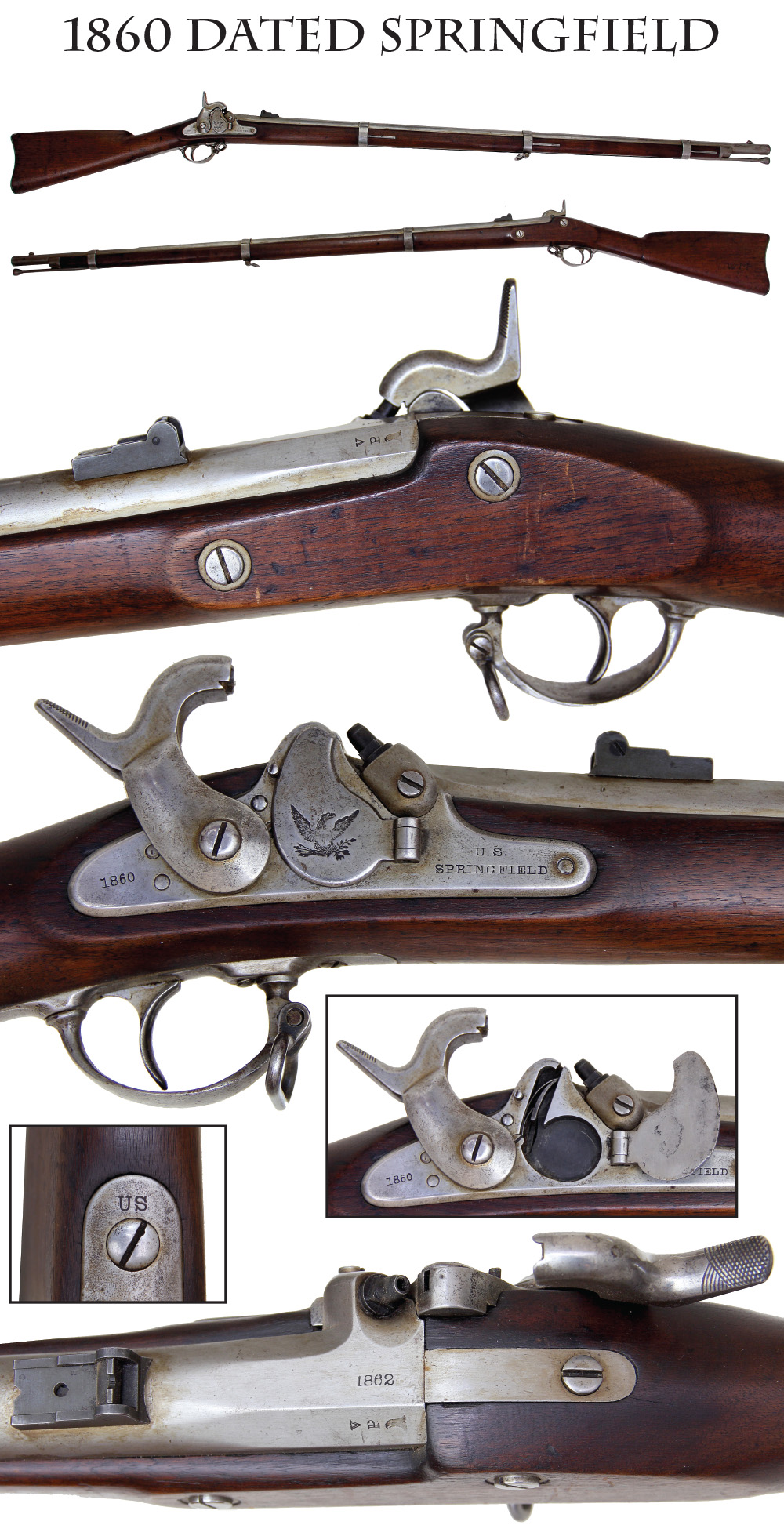
15-03-45 … M1855 Rifle Musket with Springfield M1861 Barrel:
Overall VG to near fine. Interesting as this musket carries a barrel from Springfield Arsenal bearing an 1862 date. Since this barrel is a darn rare commodity to find on the loose, I am inclined to believe the barrel was replaced during the war. Clean steel, strong markings, VG wood, no visible cartouche, late 1864-5 era rear sight. Whether this musket was upgraded in 1864 or by a collector in 1964 I cannot say with certainty. What I can say is that it is a rare item regardless. Every part is original and every part except the rear sight is an early rare item. Great early ’55 musket … adjj
… $2,250.00
– SOLD
Click Here to E-mail Us!
Call us @ 419-842-1863
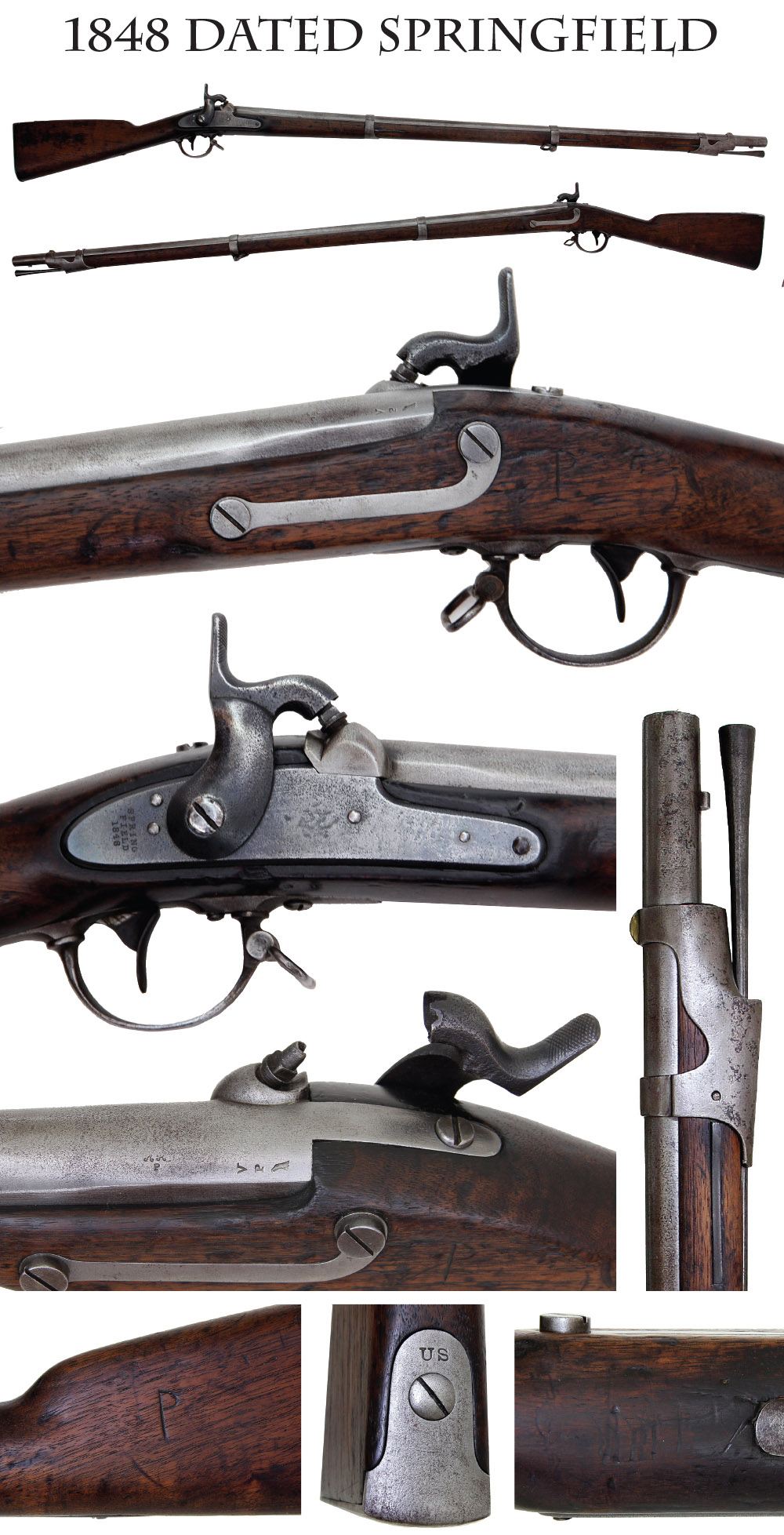
15-03-46 … US Model 1842 Springfield Musket …
The last of the .69 caliber U.S. muskets and the first of the percussion long arms for general issue to infantry, though still intended to spew out buck and ball rounds at the enemy. These are key pieces in US martial arms development. One innovation in the 1842 Pattern Percussion Musket was its use of fully interchangeable parts. Another was its production at both the Springfield and Harpers Ferry Armories. Here is an example with a Springfield 1848 dated lock and a Harpers Ferry Barrel. Overall VG condition. Most markings are clear. The eagle forward of the hammer is too light to make out, though the Springfield and 1848 date behind the hammer are sharp. The barrel has been gently cleaned to a light silvery gray and shows minute salt and peppering that is not obtrusive. There is deeper pitting at the muzzle forward of the nose band. Despite the cleaning the barrel shows clear V/P/eagle proofs at the left breach, and just forward of them the Harpers Ferry barrel proof of AR/P for Adam Ruhlman, who was inspecting barrels ca. 1850-52. Rod and swivels, all bands and front site and bayonet stud are in place, the hammer face shows a slight chip, as does the nipple, which sits a bit high and is certainly a replacement. The wood has mixed light brown and darker tones. No cartouches are visible, but a soldier or owner scratched a “P” into the butt stock and the side flat aft of the side plate. Edges show rounding from actually use, and the wood has numerous age dings as should be expected, but is solid, with no cracks or edge chipping. These guns saw a lot of use early in the Civil War in the hands of volunteers rushing to the battlefield on both sides … hej
… $1,075.00
Click Here to E-mail Us!
Call us @ 419-842-1863

15-03-47 … Classic Civil War Enfield Rifle Musket w/ Sling:
The quintessential Enfield as used by both Union and Confederate infantrymen, this one made by Robert Hughes. NRA “very good+” condition. 100% original, 100% complete, mechanically perfect, and very handsome. Still affixed is a VG+ original US made rifle sling with both loop adjusters still in place. Lock is clearly marked “1862 TOWER” and bears the CROWN stamp. The barrel bears the proper 25*25* stamping showing the gun is .577 caliber and as such there are 25 bullets to the pound. This 25*25* mark and the lesser seen 24*24* stamp are the proper ones for Enfields sent over for use during our Civil War. (24*24* indicates .58 caliber.) Numerous British stock markings present as shown, by Robert Hughes of Birmingham. RH & crown twice and full oval cartouche on right side of butt stock. Also marked on barrel “RH”. . Small crack near lock screw on left stock flat. Owner’s name “JOHN KORWIN” is scratched into the butt stock. I cannot find an infantryman with that name in the rosters, but do find a late war cavalryman from New York. You can research further. A top notch example that you can be proud to display. The sling is worth $250 or more
… $1,595.00
– SOLD
Click Here to E-mail Us!
Call us @ 419-842-1863
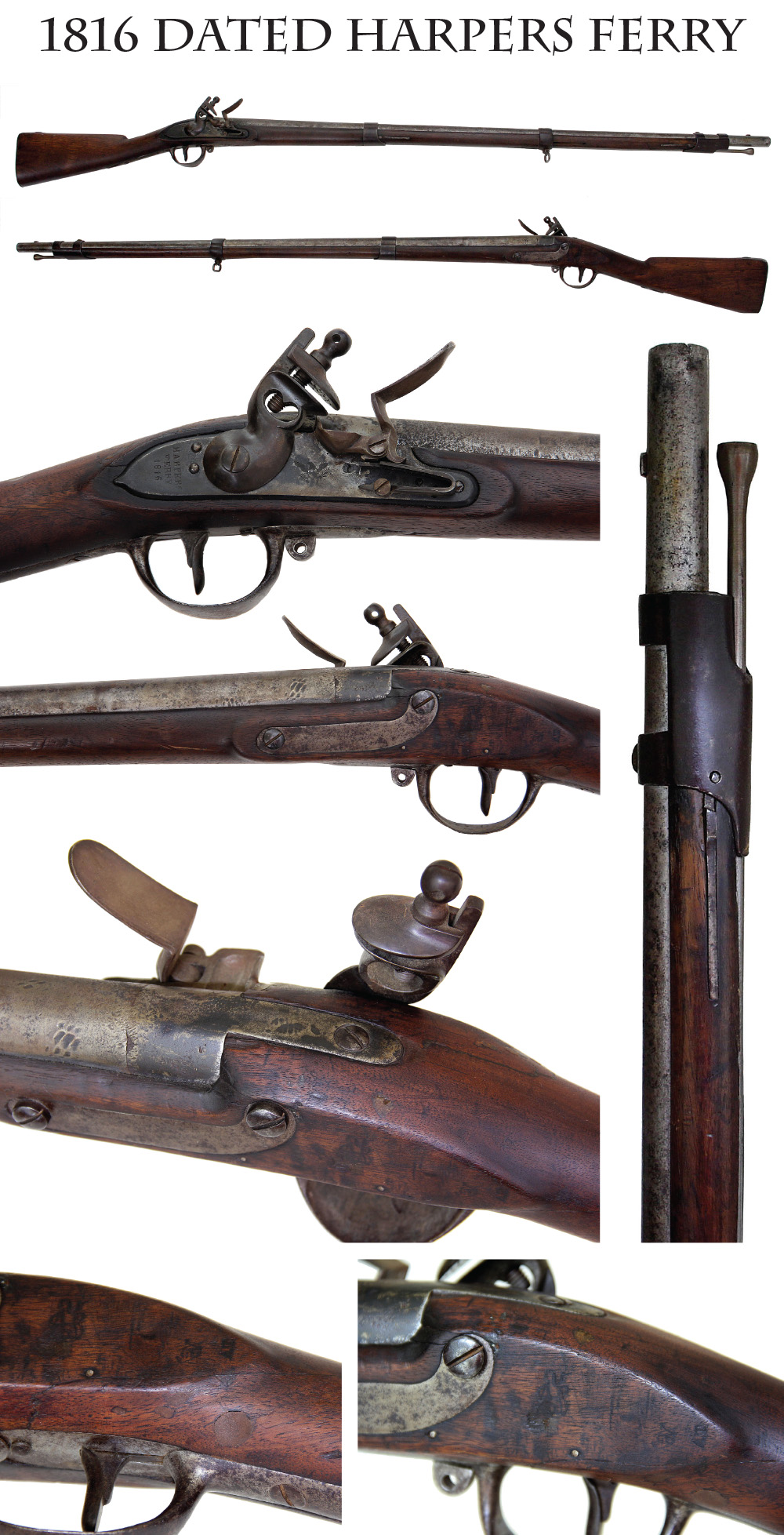
15-03-48 … 1816 Dated Harpers Ferry …
1816 Harpers Ferry Lock on this Reconverted Musket: This gun was so cheap I had to buy it! Whether you want one to hang on the wall or use in reenacting… here you go. The stock is full length and shows ink cartouches and stamps on the left side. There was some repair made to the wood just aft of the triggerguard on the offside – I see three plugs of wood filler on the bottom of the wrist and a small one at the top. The general configuration of the gun is that of a 1795/08 musket. The barrel has a separate breech and breechplug showing that it was converted to percussion, likely for use in the Civil War. After it passed its working life, however, someone decided to return it to its flint configuration and found an 1816 dated Harpers Ferry lock to fit it. Aside from the plugs, the wood is not bad. The lock apron shows pretty sharp edges as does the reverse, along with some ink and stamped cartouches. There are the usual small handling dings and discolorations, but nothing too bad. The barrel is gray overall with dark spots, some minor corrosion and a couple of vice marks near the breech. The bands are darker. The lock plate shows some mottled color and the brass pan has a dark patina. The Harpers Ferry 1816 stamp behind the hammer and the eagle forward of it are strong. The front sight is in place. The upper swivel is there. The lower swivel is missing but the lug is present. The ramrod is a reproduction rod for a ’63 Springfield that should be changed out if you are going to hang it up. It’s a bargain at
… $735.00
– SOLD
Click Here to E-mail Us!
Call us @ 419-842-1863
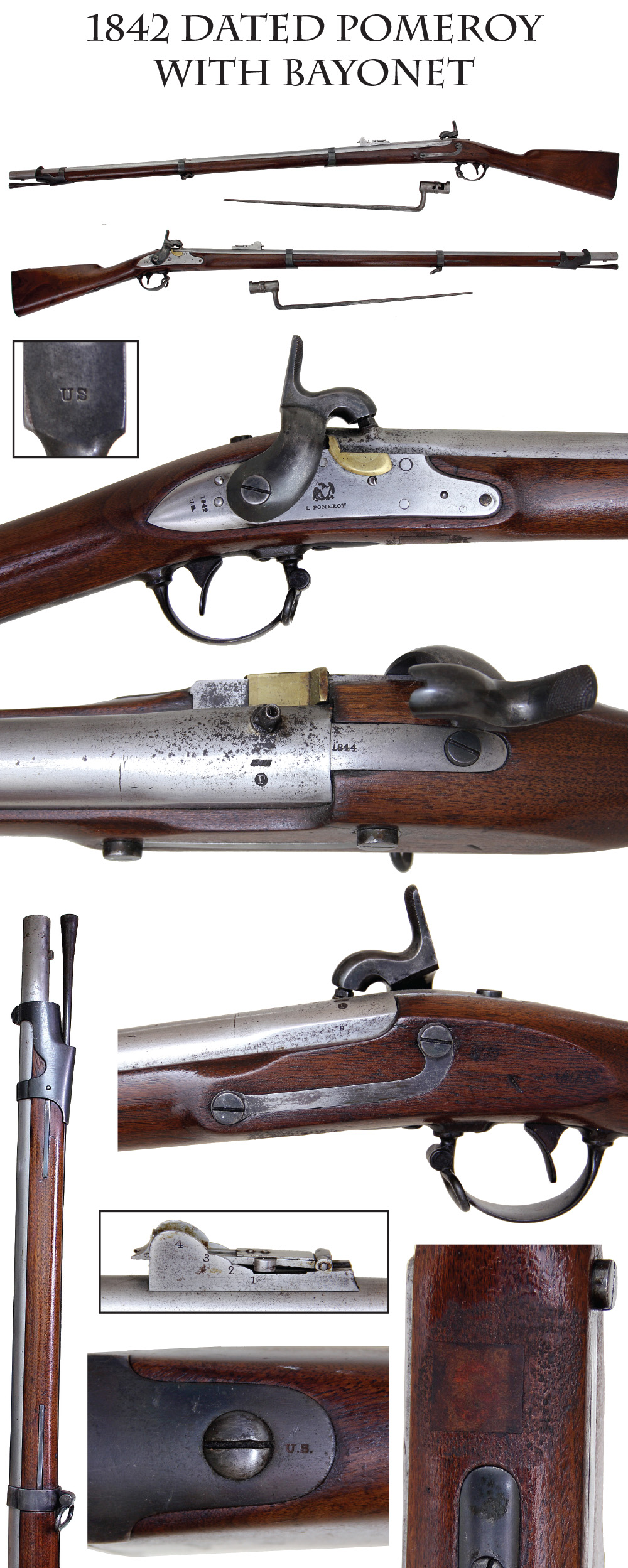
15-02-49 … Rifled and Sighted m1840 Musket by Pomeroy With Arsenal Conversion and Bayonet …
Also known as the Model 1835 and 1835/40, this was the last of the standard US infantry flintlock muskets made for the US Army. It introduced a number of changes used on the subsequent US models such as interchangeable parts. A few model arms of this 1840 pattern were made at Harpers Ferry, but when production actually started in 1840 they were produced only at Springfield and by two contractors: Nippes and Pomeroy. Whenthe government decided to alter its flintlock arms to percussion these were automatically classified as candidates for the arsenal cone-in-barrel conversion and most were altered before leaving government arsenals, being regarded as equal to the M1842 percussion arms. The heavier construction of the musket and thicker barrel also made it a prime candidate for rifling and use of the new minie ammunition that became standard with the 1855 series of arms. Ours is a very nice 1842 dated example by Pomeroy, who produced about 7,000 of them between 1840 and 1846. Very clear 1842 over U.S. marks at rear of hammer and eagle over “L. Pomeroy” forward. Very clean lock plate and metal “in the bright.” Some slight softness to the marks, but in this case it appears to befrom the arsenal cleaning when they converted the musket to percussion by removing the external flintlock parts, shaving down the flashpan, etc. Thebarrel shows clear inspection and proof marks and a distinct 1844 date on the breech plug tang, which is acceptable on these guns since the parts were interchangeable when they were disassembled for conversion to percussion and then for rifling and sighting starting in 1856. Nice light brown color and edges to the wood,and two visible ink cartouches on the offside opposite the lock. The wood was gently cleaned and varnished by a previous collector. Very few dings or handling marks to the wood. The only defect is a small square patch that was inlet on the underside near the trigger guard tang. Metal is smooth and in the bright with the exception of some firing corrosion around the nipple and a slightly darker toneto the hammer and mounts. All bands,springs, swivels, bayonet stud and sights are in place, including the complete model 1855 long range rear sight. Bore is goodand mechanically functional. Ramrod is an original trumpet head 1835 / 42 rod. When the 1816 pattern muskets were found to be too weak for rifling the government moved these 1840s to the head of the lineand they quickly made their way into the hands of troops on both sides in theCivil War. They were sturdy and dependable enough that they were in the field throughout the conflict and we even find the pattern of 1864 cartridge boxes made for their “elongated .69 caliber” cartridges.
Optional Original 1835 / 40 / 42 bayonet available for
… $175.00
Musket alone … xxi
… $1,250.00
Click Here to E-mail Us!
Call us @ 419-842-1863
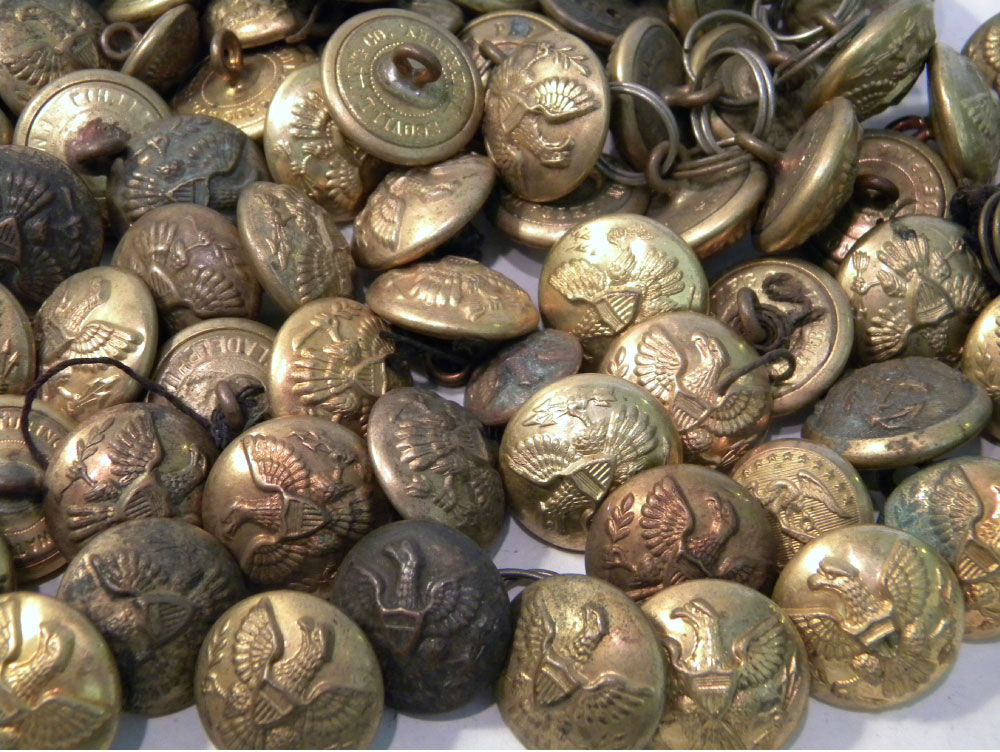
15-03-50 … A lot of TEN Original Indian War Large Size Eagle Coat Buttons.
A few years ago at an eastern Pennsylvania auction I bought a couple large bags full of these early Indian Fighters buttons and then I put them aside and forgot about them. I just stumbled across them again …. So here is a great opportunity…. ten original buttons for $25.00 These can be mailed inexpensively in a padded envelope.
… $25.00 for 10
Click Here to E-mail Us!
Call us @ 419-842-1863
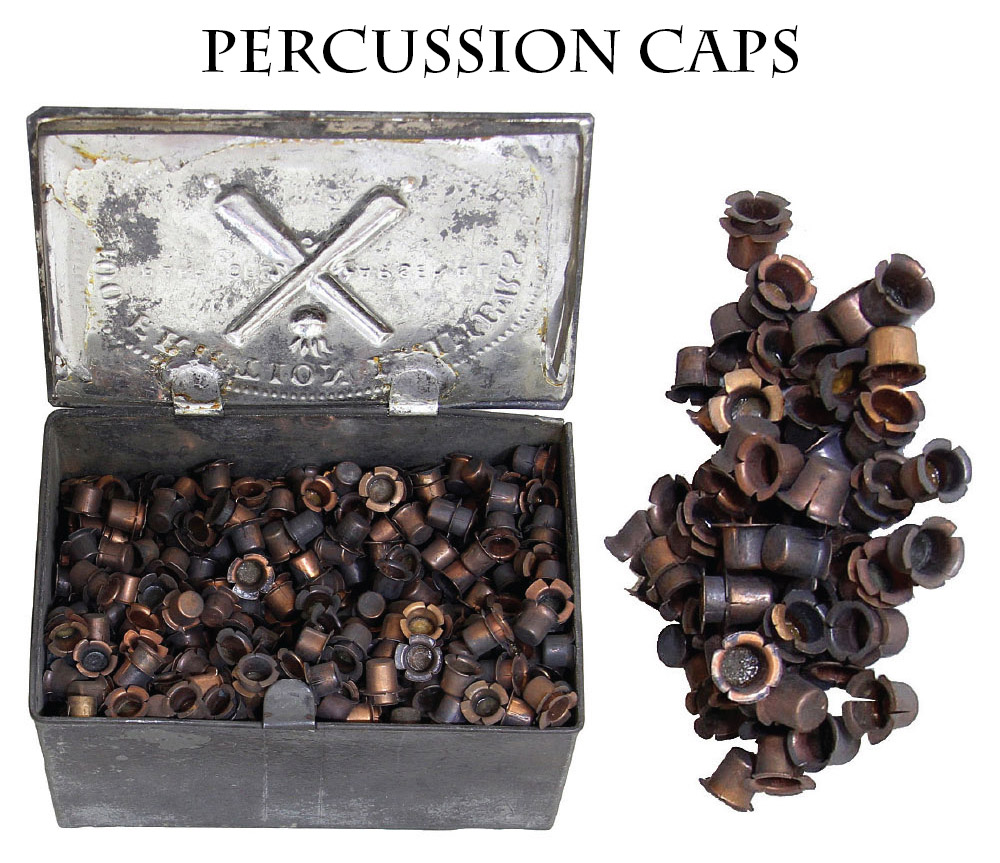
15-03-51 … Friction Primer Tin [Tin not for sale] and Percussion Caps …
I just purchased this neat old relic and am offering the percussion caps inside the tin in this offering. This very scarce tin came just as you see it, filled with percussion caps for muskets. The tin itself is the arsenal tin used to hold artillery friction primers. These are darned hard to find! I can only think of one instance where I found one still in a primer pouch! The tin has a hinged cover with small latch and embossed top reading: 100 FRICTION PRIMERS in an arc over an ordnance insignia, and FRANKFORD ARSENAL on either side. I don t know who put the percussion caps in the tin, it was certainly a handy storage idea, but since they do not belong together, I am splitting up the lot.
In each package of ten cartridges the soldier got 12 caps. While the supply lasts I will sell the percussion caps …
One Dozen … … … $15
Two Dozen … … … $25
Five dozen … … … $50
Click Here to E-mail Us!
Call us @ 419-842-1863
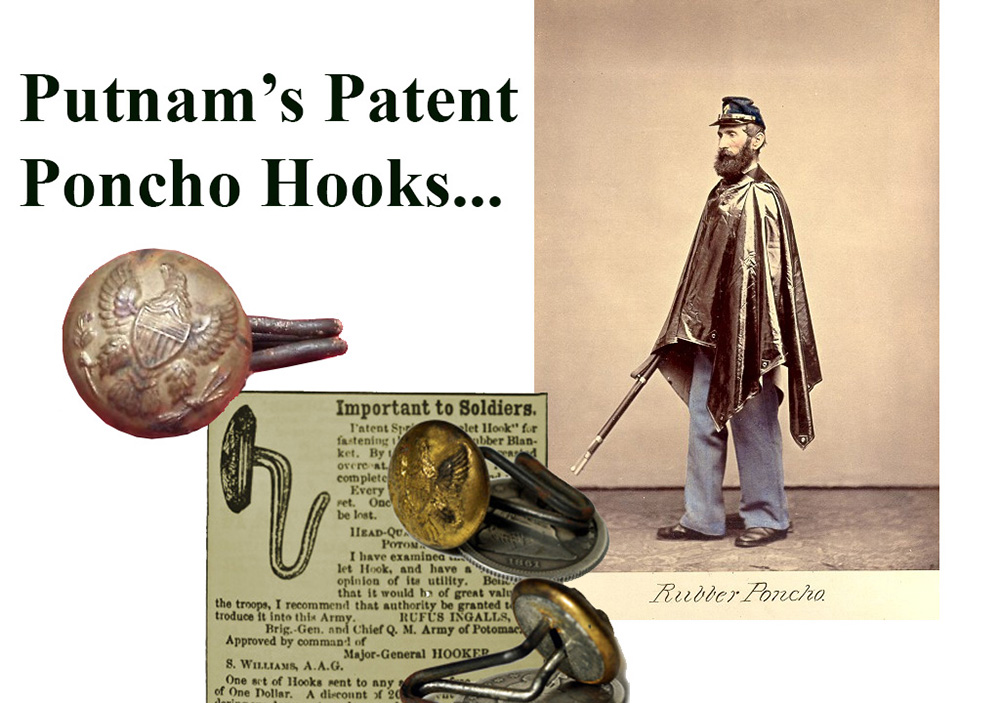
15-03-52 … These buttons were patented in 1862 by Abel Putnam
and made with a long spring shank and were designed to go through the grommets on issue rubber blankets so the sides could be connect ed and the whole thing worn as a poncho in rainy weather.The face is a standard Union Army eagle button. The back is a spring hook fashioned from double spring steel wire. I have very few priced each at
… $45.00
Click Here to E-mail Us!
Call us @ 419-842-1863
Layaways are Welcome
Need to split your order into multiple payments? No problem! A simple 20% earnest money deposit will hold your item for you.-acf
You can then pay it off in easy installments that fit your budget.
Read Terms Here
Items to Sell? Contact Us
I am always interested in buying ANYTHING from the American Civil War… Guns, Swords, Civil War Muskets, Knives, Uniforms, Flags, Medals, Badges, Diaries, Letters, Autographs, Buttons, photographs, tintypes, daguerreotypes, Insignia, Camp Items, Battlefield Relics, canteens, Drums, Etc… Call 419-842-1863 and ask for Dave Taylor.

